Powell’s Gettysburg Moment, the USD’s Waterloo & Today’s Open Madness
Below we examine the historical interplay of losing wars, cornered egos, tanking currencies, greater controls and gold’s loyalty in times of open madness.
History Matters
Despite the fact that universities even in the Land of Lincoln have had a say in cancelling Abraham Lincoln (good grief…) for apparently not being “woke” enough circa 1861 to be as wise as the neo-liberal faculties of 2023, I’d still make a case that history matters, and by this, I mean all its wonderful and ugly nuances (and lessons), whether they offend modern sensibilities or not.
History, of course, is full of desperate figures and times, many of which involve desperate economies followed by equally desperate (proxy) wars and desperate turning points.
In this light, the more things change, the more they stay the same. Just look around you…

And in the largely forgotten history of war, there is no shortage of desperate generals at desperate turning points.
Wars Doomed from the Start
Napoleon, who having previously won countless battles from Rivoli to Austerlitz, found himself shivering through an 1812 Russia after losing the vast bulk of his army to General Russian Winter and remarking to one of his generals that it’s “only a fine line between the sublime and the ridiculous.”
Three years later, at Waterloo, Napoleon’s “sublime” days (and countless casualty numbers) ended for good.

At Gettysburg, on the 3rd day of July, 1863, an equally talented and grossly outnumbered Confederate States Army under Robert E. Lee, having humbled Union forces at Manassas 1 & 2, Fredericksburg, Gaines Mill and Chancellorsville, looked across an open field from Seminary Ridge to the Emmitsburg Road strewn with the dying and dead of his once bravest divisions as the U.S. Civil War reached a mathematical turning point.

Despite this carnage, the war (post Pickett’s doomed July 3rd charge) dragged on for 2 more horrendous years (and countless casualty numbers), ignoring the hard math of waning troop numbers, supplies, cannons and horses which now rendered Southern “victory” impossible.
Less than a century later, this time near Stalingrad in the winter of 1943, the seemingly invincible German Wehrmacht, having conquered Poland, France, North Africa and large swaths of the East, found itself (and General von Paulus) facing the equally mathematical reality of what once seemed like impossible defeat.

By all metrics the Germans, having engaged in a two-front war, were done, but the war (and countless casualty numbers) would continue for two more senseless years.
But what do any of these examples of doomed and costly wars have to do with current global markets and our financial “generals”?
In fact, quite a bit.
Financial Policies Doomed from the Start
The overlapping interplay of human ego, hard math, and failed strategies doomed from the start have their place in both military and financial history.
For example, once upon a time (circa 2008), our central bankers in general, and the U.S. Fed in particular, had the insanely bad idea that central banks could use fiat money created out of thin air to save bad banks, defeat recessions, manage inflation, monetize debt, win a Nobel Prize and ensure total employment with a “Pickett’s charge” of mouse-click money.
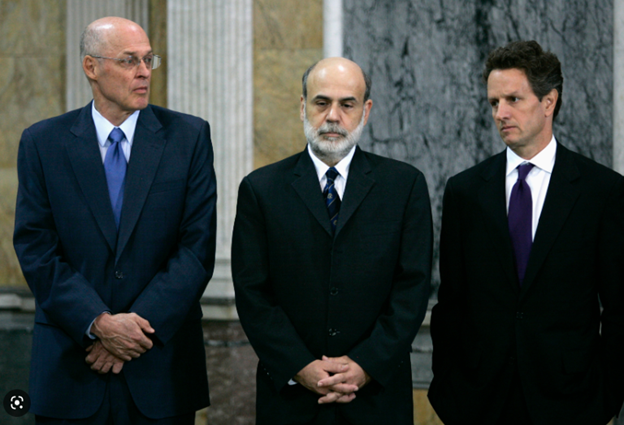
Such grand plans, like the promises of failed generals and insane wars of Lebensraum, la gloire de l’empire or the “Southern Cause,” were initially followed by a string of early “Austerlitz-like successes” (i.e., market bubbles) which brought near-term euphoria.
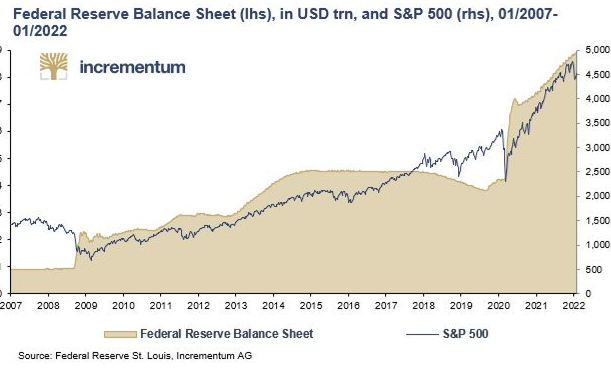
Unfortunately, those early and mouse-clicked victories ignored the longer-term realities/casualties, namely: historically unprecedented wealth inequality, grotesque currency debasement, the death of free-market price discovery and the birth of what amounts to little more than Wall Street socialism and market feudalism masquerading today as MMT “capitalism.”
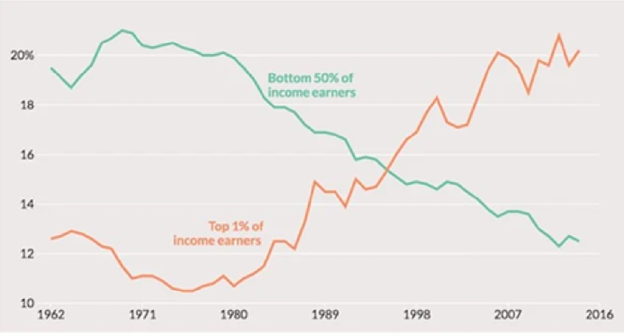
Such short-term “glory” at the expense of longer-term ruin is a pattern all too familiar for those paying attention…
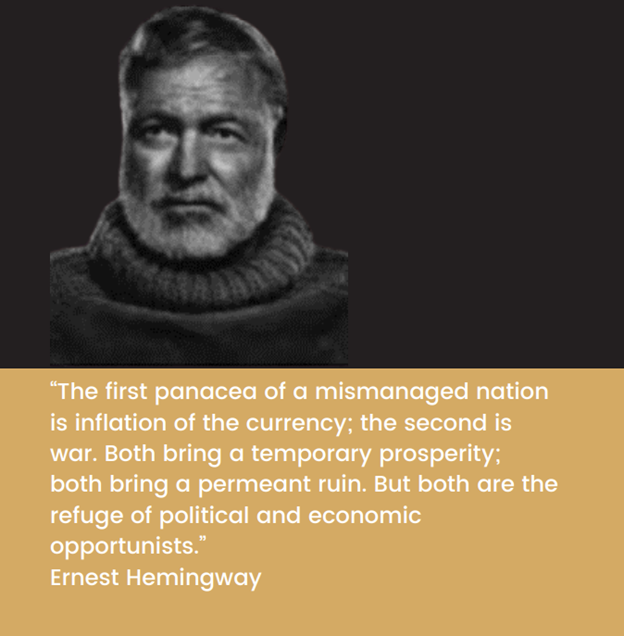
Emperor Powell, for example, thinks he can “win the war against inflation,” but like Napoleon, Lee and von Paulus, he is still unable to admit to himself (or us lieutenants) that his grand vision is doomed either way.
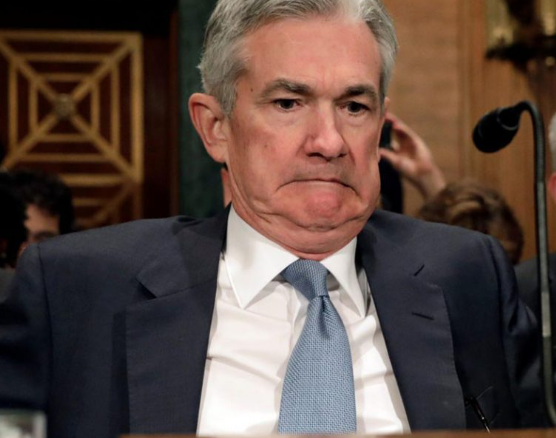
And so, he continues to desperately fight a losing cause at the expense of countless currencies and investors (casualties) around the world.
How can we know this?
It All Boils Down to Hard Math and Bad Options
As detailed in prior reports, the math speaks for itself.
Global debt levels are past their “Gettysburg moment”—there are no easy victories left once we start dealing in the quadrillions…
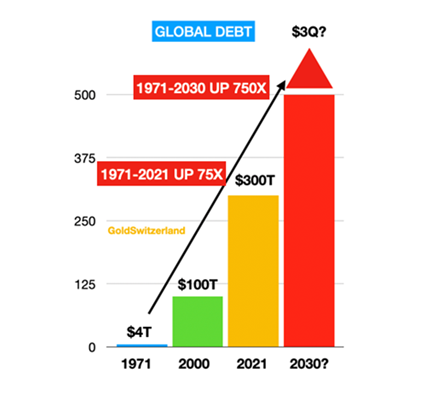
Whether Powell continues with QT or pivots to more QE, retail foot-soldiers here and abroad face either economic recession/depression or extreme inflation.
Pick your “victory” or your poison. I see both, namely: Stagflation
Equally serious is the inevitable demise of the USD’s purchasing power at home and the slowend of its hegemony in the world.
The Sad Fate of the USD
Regardless of whether the USD (DXY) rises or falls in the near-term, the end result is as inevitable and mathematical as Germany’s two-front war, Pickett’s charge or Napoleon’s Waterloo: Disaster.
Once stock and bond bubbles reach their tipping points, the last bubble to die is always the currency, which is precisely where our prize-winning (?) central bankers have placed us.
In short, and as shown below, the global economy and USD, led by Field Marshall Powell, is about to cross that infamously fine line from the sublime to the ridiculous…
The USD’s Sublime Last Moments
As in any losing war, however, there are always those clinging for hope, including those who think the USD will never, well…surrender. (In 2022, the British pound, the yen and the euro already caved…)
Recently, for example, the headlines, politicos, markets and perma-bulls were positively giddy over the stronger than expected US jobs report and non-farm payroll data. The DXY climbed in lock-step.
However, what was equally higher (60% higher…) than expected was the 2023 US Treasury borrowing estimate –aka: Uncle Sam’s increasing bar tab–$930B! –for Q1 alone.
Each of these data points has sent the USD temporarily higher, along with inflation expectations, which now seem to be embedded.
So, the big question today is this: Will the USD get stronger or weaker in 2023 and beyond?
There are two camps in this strategic debate, and two consequences depending on which camp is right. Neither are “victorious.”
Bad Scenario 1: A Rising Dollar’s Consequences
If the USD gets stronger, it kills just about every asset class but the USD…
Already, we are seeing this open carnage in credit markets as rising rates and General Powell’s strong-Dollar policies cripple lending and borrowing norms of the past.
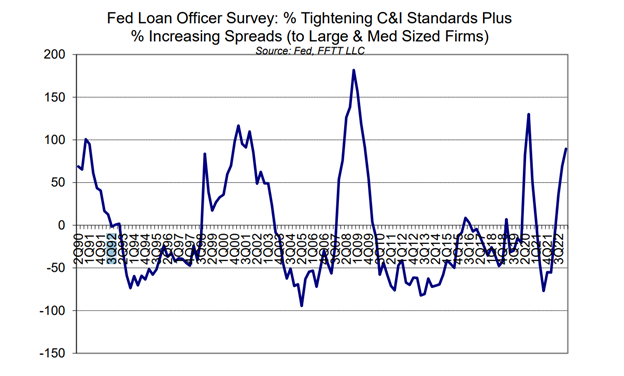
Loan officers are confirming a tightening of credit availability (and a widening of bank lending spreads, above) at levels only seen in prior recessions, adding more weight to my ongoing contention that the US is already in a recession, despite every Göbbels-like attempt in DC to redefine, cancel, ignore or downplay the same.
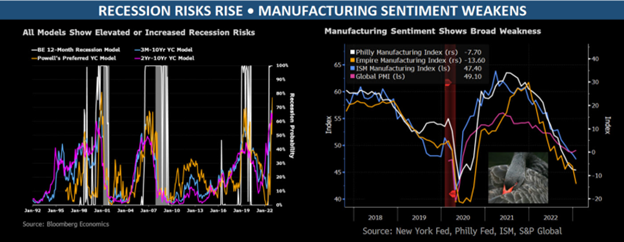
The equally dismal rise of defaulting High Yield bonds adds further proof of the slow (then steady) death of bleeding bonds in a rising rate and strong USD backdrop/policy.
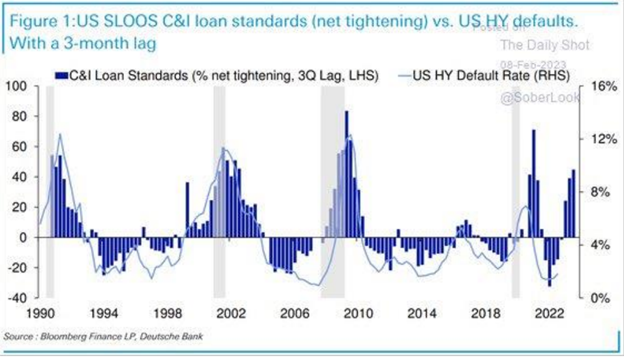
A strengthening USD will send bonds down and hence yields and rates higher, which will be deflationary as debt-soaked America gets poorer and foreigners are forced to sell more USTs alongside a tightening Fed which is doing exactly the same thing—namely: Bond dumping and yield-spiking.
Bad Scenario 2: A Falling Dollar’s Consequences
However, if the USD gets weaker, the inflation we are already feeling will only get worse as $2T+ deficits make their steady climb North toward $3T, $4T or even $5T+ for 2023.
So, once again: Will the USD get stronger or weaker?
The answer lies in what signals (or desperate generals) you track or trust: Powell’s Fed or the UST market?
Trust What Powell SAYS?—Strong Dollar Ahead
If, for example, you follow the Fed and its bogus yet deadly-serious inflation narrative, then you will be lured into Powell’s “we must beat inflation” war cry, which boils down to a zero-sum battle-plan of “high inflation bad, low inflation good. Must beat inflation.”
Equally part of this bogus battle plan (Powell needs inflation and negative rates…) is the courageous meme that “rising rates kills inflation.”
Well… yes, but at what cost?
If Powell wins the headline battle against inflation, he loses the war for global credit markets, economies and political credibility, which loss will be immediately blamed on a virus and Russian bad guy but never on the mad generals who pushed us over the debt cliff.
However, if we get beyond linear headlines and two-dimensional thinking of central bankers like Powell, we quickly realize that the 3-dimensional UST market is perhaps the real (and superior) indicator of future probabilities.
Or, Trust What Bond Markets DO?—Weaker Dollar Ahead
Thus, rather than watch the Fed, I’m looking at bond markets to get my directional compass-North in a world of policy cannon smoke.
As said more times than I can count: The bond market is the thing.
And as for the sovereign bond market, it has seen 3 periods of complete dysfunction in recent years, namely: 1) the repo rate spike of September 2019; 2) the March 2020 “Covid” crash, and 3) last October’s gilt implosion spawned by the rising USD.
Those who follow the Fed (and this is entirely understandable given that the Fed IS the market in our post-2008 centralized nightmare) can’t be blamed for therefore expecting the USD to rise on more tightening and Powell “inflation-fighting.”
But those who follow the Fed are also ignoring those 3 bond market cracks in the ice above.
It’s my view that this ice is about to break if we have a 4th “uh-oh” moment/crack in sovereign bonds.
Thus, rather than follow the Fed, we might be wiser to look at the UST market, which is heading precisely in that “uh-oh” direction unless someone (i.e., Yellen?) pushes another meme—namely more toxic liquidity and thus a weaker USD.
But as previously argued, either way we are doomed…
Failed Battle Plan 1: Tightening into a Debt Crisis (Stronger Dollar)
Let’s play out the Fed’s current scenario first.
If we look only at what the Fed says, and it tightens, which, for now seems like the plan for Q1 and Q2, the USD will strengthen, yields and rates (5% to 5.25%) will rise further and the UST market will see such a wave a selling (foreign and QT Fed-driven), that a fourth “uh-oh” moment in the sovereign bond market will be inevitable, and likely enough to not only “crack the ice” of global bond markets, but drown everyone skating above it.
Given these realities and risks in the UST market, risks which even a fork-tongued and totally cornered Jerome Powell understands, I see no realistic way forward other than a weaker USD and thus a move from QT to QE.
Why?
Again: Because I’m taking my signals from the bond market not Powell.
To track (and trust) Powell means a tanking US Treasury and fatally rising rates, which is like kryptonite to America’s debt-based “accommodation” model.
Instead, I believe Powell will be forced to strategically consider the fact that this inflation war has killed his army of USTs and hence force him (at Yellen’s direction) to change tactics.
Or stated more simply, just as Napoleon, Robert E. Lee, and even the Wehrmacht learned that no outnumbered army can win an extended war, Powell will discover that no sustained policy of rising rates can end well for the toxic bonds/IOUs which float a bankrupt nation.
In short: Unless Powell weakens the USD and injects more QE liquidity sometime in 2023, his victory over inflation will be at the expense of America’s life-blood—namely the UST market.
Failed Battle Plan 2: Resort to More Mouse-Click “Miracles” (Weaker Dollar)
At the end of the day, and despite all this “beat inflation” rhetoric from Powell, it is my admittedly contrarian and unpopular (don’t say “gold-bug”) view that saving Uncle Sam’s IOU lifeline (i.e., the UST market) will take strategic priority over “beating inflation.”
By the way, this appears to be a view shared by none of other than that Corps Commander of toxic liquidity herself: General Janet Yellen…
In other words, expect an eventual (not immediate) capitulation to more fake money—aka, QE, i.e., “liquidity.”
This means that despite gyrating USD moves and hence DXY flip-flops today, the only direction and choice in the longer term to beat a recession and save Uncle Sam’s IOUs is a weaker not stronger Dollar.
Ultimate End-Game? Blame, Reset and Centralized Control
A weaker USD will buy time (and USTs) until ultimately the developed economies of the world, which in fact have the balance sheets of banana republics, finally realize that there’s still nothing left to save them but a great big “reset”—i.e., a global Chapter 11 or Economic “Versailles Treaty.”
The need for this “re-set” will, of course, be conveniently blamed on Putin and Covid rather than the central bankers (failed generals) who caused this horrific war on real money, sustainable debt and sound fiscal spending years ago.
At that point, history will remind us that lost wars and failed policies always devolve into more centralized controls masquerading as governmental “guidance,” payment efficiency and “democratic” leadership, nicely encapsulated in that toxic new direction of Central Bank Digital Currencies and a more Orwellian new normal…
But I digress…
How to Position Yourself?
Switching from military to equestrian metaphors, I argued in 2022 that investors, like polo players, need to think where the ball is headed, not where it lies currently.
Regardless of what Powell says today, the real play is 3 to 4 moves ahead, which all point toward an inevitably weaker USD and thus an inevitably rising gold price.
Powell, of course, is more politician than economist, and central banks like the Fed are anything but independent.
As such, Powell, DC and the creative math and fiction writers at the BLS will continue to do what all politicians (or losing armies) do when things are going against them: Lie.
Thus, the DC creative writers will continue to fudge, distort and “tweak” the CPI data to mis-report true inflation as nearly “beating expectations,” thereby allowing Powell to save face in a losing “war against inflation” while Lieutenant Yellen quietly pushes a weaker USD narrative to save the UST market (i.e., prevent more foreign UST dumping).
This face-saving policy will then allow the US to do what it does best: Borrow, spend and go deeper into inflationary debt spirals.
The Pesky Human Factor
Based on bond market Realpolitik, the probabilities point toward a liquidity pivot and weaker USD, longer term.
But history also reminds us that power-drunk figures don’t like to admit defeat. Their egos get in the way of rational decisions.
Powell, who desperately wishes to be remembered as a Napoleonic Paul Volcker rather than a comical Arthur Burns, is no exception to such human-all-too-human small-mindedness.
Unwilling to accept a Gettysburg moment that originated with Colonel Greenspan, General J. Powell could indeed push too far and too long with rising rates, a stronger USD and tanking bonds until inflation and everything else is destroyed.
We can only wait and see.
The Gold Factor
Whether on battlefields or economic cycles, man’s history of the absurd and his disloyalty to the many for the benefit of a few is nothing new under the sun.
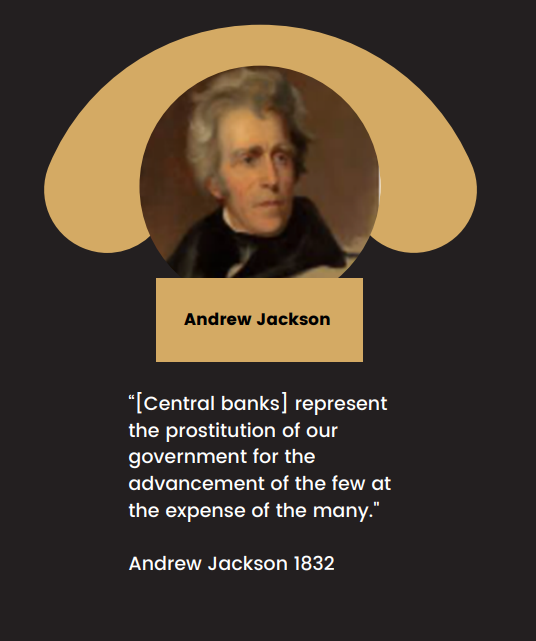
In short, chaos eventually rears its head.
Powell or Yellen, QT or QE, inflation to deflation, left or right, Davos or DC, the chaotic results are always the same: Currencies and markets die, opportunists, lies and controls increase and the little guy (and common sense) gets trampled, drafted or “cancelled.”
Physical gold, of course, loves chaos and offers far greater loyalty to those who put their trust in this natural metal rather than flimsy paper money and the even flimsier promises from on high.
So which form of money will you trust to preserve your wealth?
A digital and speculative “coin” promoted by human cons that is anything but stable?
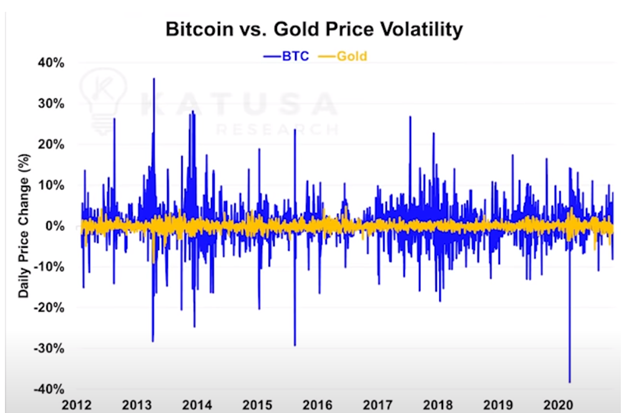
A fiat currency that is losing its purchasing power by the second?
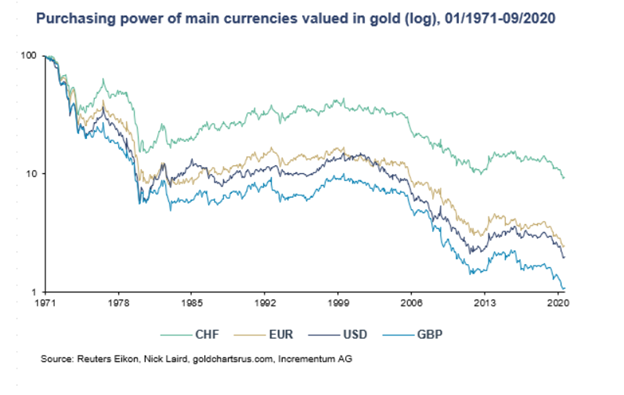
Or a naturally finite monetary metal with infinite duration born from the earth rather than an anonymous code writer or over-heating printer?
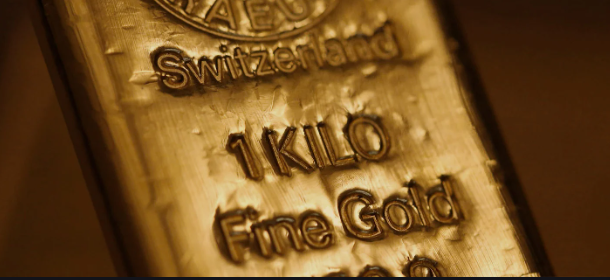
The choice, of course, is yours.
Powell’s Gettysburg Moment, the USD’s Waterloo & Today’s Open Madness
Below we look at the interplay of embarrassing debt, dying currencies and failed monetary fantasies masquerading as policies to confirm that no matter how one turns or spins the inflation/deflation, QT/QE or recession/no-recession narratives, the global financial system is already doomed.
Recession: The Elephant in the Room
As I’ve been arguing in report after report, my view has been that the US, with its 125% debt-to-GDP and 7% deficit-to-GDP ratios, was, and already is, in a recession heading into 2023, despite official efforts in DC to re-define the very definition of a recession.
But a recession is still a recession, and an elephant is still an elephant, and both are fairly easy to see at a distance.
As of now, however, the recession has officially been avoided.
How comforting.
As with the inflation data, it’s nice when the folks in Washington can exercise their magical powers to move the goal-posts in mid-game whenever a little “cheating” helps their odds and fictional narrative.
For me, an elephantiac recession is now in the room.
The Empire Manufacturing data in my latest report, for example, supported this recessionary outlook.
In case, however, we still need more recessionary evidence, the dramatic 6 month decline in the Conference Board’s index of leading indicators serves as yet another neon-flashing warning that the recession—if not under our bow—is certainly right off our bow.
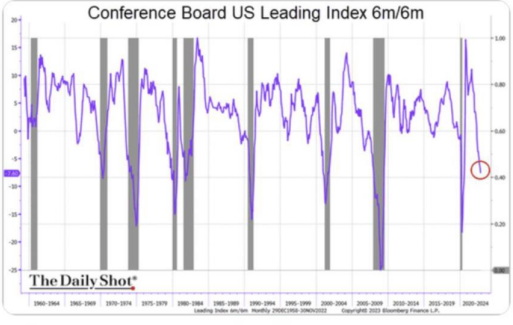
Still Hoping for a “Softish” Landing?
Furthermore, and despite Powell’s belief that his office can manage a recession with the precision of a home thermostat, his faith in what he lately described as a “softish landing” is almost as farcical as his prior attempt to describe inflation as “transitory.”
Without wishing to appear “sensational,” as many of us blunt and math-based observers (from Burry to Middelkoop) of late are described, I will stick my tin-foil-covered head out and say candidly that I see nothing “softish” ahead.
Instead, I see either: 1) a financial crisis which will dwarf 2008 and/or, 2) an absolute tanking of the USD, whose unsustainable strength throughout 2022 was indeed “transitory,” as I argued numerous times.
The Simple Math of Liquidity
The simple math and reality of even centralized and central-bank distorted markets is quite simple: These markets rise and fall on liquidity.
Once the monetary “grease” required to maintain the MMT fantasy of mouse-click money as a debt solution “tightens” too tight or runs too dry, the entire house of cards of the post-2008 fairytale comes to a hard rather than “softish” end.
Again, we saw the first signs of this collapse in the “tightening” backdrop of 2022.
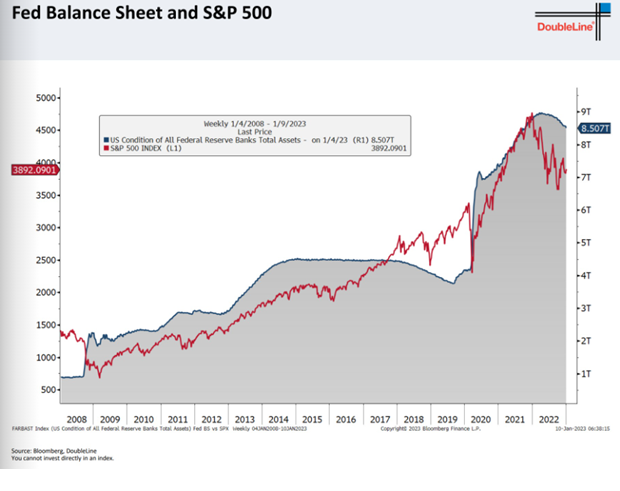
Of course, this critical “liquidity” won’t be coming from economic growth, rising tax receipts, a robust Main Street or a fairly-priced market.
Instead, and as expected, it now comes from out of thin air…
Is It a Race to the Bottom for Risk Assets?
The honest but scary numbers rather than fluffy but fictional words of our financial central planners make it all too clear that unless Powell puts his finger on the Eccles-based mouse-clicker to create more fiat money (highly inflationary), US and global credit markets will simply continue their race to the ocean floor (highly deflationary or at least dis-inflationary).
As credit markets sink and bond yields and rates rise, this also means that equity markets, who have been sickly addicted to years of central-bank repressed low rates and cheap debt, will merely join those bonds on the bottom of the dark ocean floor.
In short, bonds (and hence risk parity portfolios) won’t save you. Rather than hedge stocks, they are now correlated to the same.
More Easing Won’t Bring “Ease”
Failing outright and open bond default, it thus seems that an eventual capitulation to more magical “liquidity” and renewed QE is nothing short of inevitable, which means the USD’s fall from its 2022 highs is equally the case, as shown below.
But such “easing,” if realized, will lead to more inflationary-debased Dollars and hence more inflation dis-ease for investors.
This is hard for investors to fully grasp when the Dollar seems “strong,” but even that was an illusion, and one which hardly did any asset class any good in 2022 but for the Dollar itself.
The Damage Already Wrought by the Strong USD
In the interim, the cancerous ripple-effects of the Fed’s strong USD policies, as warned throughout 2022, continue their waves of destruction, as openly evidenced by the earnings reports from our beleaguered S&P.
Already, the early data coming from its listed companies is anything but positive.
As in the July and October earnings seasons of 2022, corporate earnings for 2023 are still drowning under the weight of the USD.
But we must also keep in mind that the DXY (which measures the relative strength of the USD) has fallen 11% (from 113.9 to 101.8) over the last quarter.
If the S&P hit an October bottom during a DXY high, what can we deduce from a now falling DXY?
Will markets rise like Lazarus?
This will be something worth tracking.
But why?
Strong Dollar or Weak Dollar, No One Wins…
Should earnings and hence stocks continue to decline despite the DXY declines, this would suggest that not even a weakening USD can save these post-08, over-stretched, Fed-addicted and debt-soaked markets.
However, should stocks rise on a weaker Dollar, the percentage gains in price will only be eaten away by the invisible tax of inflation and the increasingly debased value of the very dollars used to measure those so-called “appreciating” stocks.
In short, a no-win scenario…
For now, it seems the stock market only cares about the Fed rather than the DXY, as the Fed is the market.
That is, when QE is the meme, zombie markets rise; when QT is the meme, they fall.
Again, see for yourself:

Yellen, Squawking for a Weaker Dollar?
In fact, it was during those October market lows that the queen of toxic liquidity, former Fed-Chair-turned-Treasury-Secretary (imagine that?) Janet Yellen, was suddenly ringing the bell for more magical money—i.e., “liquidity.”
Specifically, Yellen was wondering who would be buying Uncle Sam’s IOU’s without more mouse-click money from the Eccles Building?
As my latest reports on the UST markets confirmed, the answer was simple: No one.
Instead, foreign central banks were and are selling rather than buying America’s bonds. Just ask the Japanese…
Is Yellen, contrary to Powell, silently suggesting that QT has backfired? Is Yellen, unlike Powell, realizing that there are no buyers for our increasingly issued yet unloved USTs but the Fed itself?
Perhaps these tensions within the Treasury market provide the hidden clues as to why the USD has been sliding rather than rising from the DXY’s October highs?
After all, a weaker USD means less forced need for foreign nations to dump their UST reserves to come up with the money to buy their own dying bonds and strengthen their own dying currencies as a direct response to Powell’s (and originally, Yellen’s) strong USD policy.
In short, perhaps our Treasury Secretary now wants to stop the bleeding in her Treasury market…
Weaker Dollar Ahead?
My current view is therefore this: We are seeing the slow end of the strong USD policy.
Why?
Because as warned throughout 2022, such a strong USD was a massive gut-punch to foreign currencies and hence foreign holders of USD-denominated debt.
Indirectly then, the strong USD was also a gut-punch to the UST market, which saw more sellers than buyers around a crippled globe. Hence Yellen’s backfired and back-stepping fears above…
Furthermore, and returning to the aforementioned topic of recessions, I also argued throughout 2022 that no recession in history has ever been solved with a strong currency.
Given that such a recession is, again, either directly off our bow or already under it, it is likely no coincidence that the USD/DXY is now falling rather than rising.
In short has Uncle Sam’s strong Dollar finally cried, well… “Uncle”?
Or more simply stated, has Yellen realized, in private, what we’ve been arguing in public, namely: That we are already in a recession and thus need a weaker Dollar.
Powell: Ignoring Reality & Yellen?
Meanwhile, however, you have the math-challenged but psychologically tragic Jay Powell wanting to save his legacy as a Paul Volcker rather than as an Arthur Burns.
Like a child wanting to be John Wayne rather than Daffy Duck, Powell and his rate-hiked strong USD refuses to see the $31T debt pile in front of him which makes it impossible to be a reborn Volcker, who in 1980 faced a much smaller debt pile of $900B.
In short, Powell’s America of 2023, unlike Volcker’s America of 1980, can’t stomach rising rates or a strong USD.
Or stated even more simply: Powell can’t be Volcker.
Will someone at the Eccles Building please remind him of this?
Doomed Either Way
Yellen or Powell, QT or QE, strong Dollar or weak Dollar, the global financial system is nevertheless doomed.
We either tighten the bond and hence stock markets into a free fall and economic disaster, or we loosen and ease liquidity into an inflationary nightmare.
As I’ve said so many times: Pick your poison—depression or hyperinflation.
Or perhaps both…namely stagflation.
Either way, of course, Powell, and the American economy, is now doomed. And he has only Greenspan, Bernanke, Yellen, himself and years of mouse-click fantasy to blame.
Supercore (CPI) Lies from On High
Meanwhile, the lies, twisted math and Nobel-Prize level mis-information continues…
Last week, for example, I reminded readers of DC’s latest attempt to mis-report otherwise humanly-felt inflation by tweaking an already-tweaked (i.e., bogus) CPI inflation scale.
But if that comedy wasn’t already comical enough, now welcome none other than Paul Krugman to this stage of open theatrics masquerading as economic data.
According to one of Krugman’s latest neoliberal economist tweets, “3-month ‘supercore’ CPI is below Fed’s 2% inflation target,” which naturally had those equally raggish economic playwriters at the WSJ almost galvanic with theatrical “good news.”
Hmmm.
What neither Krugman nor the WSJ seemed to recognize is that “supercore” CPI excludes food, energy, shelter and the price of used cars, so yes, absolutely, if you take away all the things that actually cost lots of money, inflation is no problem at all… Bravo!
Such shameless misuse of data and headlines, of course, is almost as shameless as the misuse of monetary policy we’ve been enjoying since the Troubled Asset Relief Program…
But as stated last week, such desperate tricks from on high will continue to mount as global financial problems do the same.
An Historical Turning Point
The astounding lack of accountability from the foxes guarding our financial hen house will one day be the stuff of history books, assuming history itself is not cancelled, as it seems the study of economics has already left the room.
The best we can hope for from the very “experts” who have brought the global economy toward a mathematically unavoidable cliff are now empty words and twisted math, as per above.
Such disloyalty from our financial generals on the eve of an unprecedented strategic and tactical economic defeat of their own making reminds me of officers sitting miles from the trenches as investors go “over-the-top” toward a row of cannons pointed straight at their trusting chests.
In short: Sickening.
Gold: A Far More Loyal Lieutenant
Gold was a far more loyal asset than stocks and bonds in the turbulent times of 2022; and given that 2023 portends to be even worse, we can expect better loyalty from this so-called “barbarous relic” of the past.
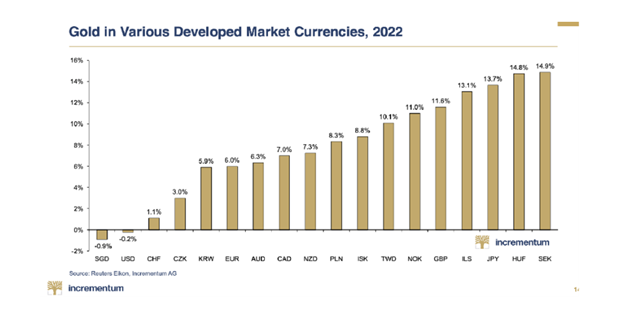
With inflation ripping and war blazing, many still argue that gold did not do enough.
Hmmm…
But gold in every currency but the USD (see above) would beg to differ.
Furthermore, and as argued so many ways and times, that USD strength will not hold, as gold’s price moves this year have already tracked.
Gold’s future strength and rise is thus easy to foresee, as gold doesn’t rise, currencies just fall.
It’s really that simple.
Got gold?
Powell’s Gettysburg Moment, the USD’s Waterloo & Today’s Open Madness
Below, we consider a blender of history, simple math, sober facts and comical arrogance to better understand gold’s loyalty in a time of disloyal financial stewardship.
Hubris Comes Before the Fall
History (whether on battle fields or sports fields) is riddled with tragi-comical examples of human blundering (and hubris) in the face of otherwise obvious and self-inflicted risk—you know: The final swagger just before imminent defeat.
Remember “Mission accomplished”?

Like well-dressed officers steaming the Titanic at full speed ahead despite repeated ice warnings, the arrogant yet misguided faith our central planners/bankers have in their “unsinkable” financial (i.e., Keynesian) models and verbal platitudes is astonishing.
If the financial model, for example, says “raise rates to fight inflation,” then the model must be right—especially given the credentials of our elite “model followers,” all collectively swimming within an echo-chamber of model-making, yes-saying, self-selecting and PhD-affirming back-slappers from MIT to Stanford, U-Chicago to Harvard Yard.
Linear Models & Thinking in a 3D World: Fantasy vs. Complexity
Yet such singularity of purpose and linear thinking (recently exemplified by openly failed COVID vaccine “models” and backfiring Putin sanctions) in an otherwise three-dimensional backdrop of ignored complexity theory reveals a staggering incapacity among our so-called policy-leaders to consider the side effects (and astonishing collateral damage) of such singular goals—such as “defeating inflation.”
Just like Napoleon’s war (and singular focus) against the Russian Tzar in 1812 ignored the subtleties of cold weather and the panache of the Cossacks, resulting in the destruction of his Grande Armee as graphically seen here…
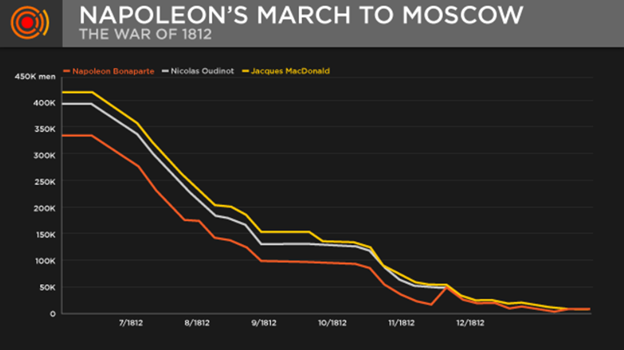
…the Fed’s 2022 war (and singular focus) against inflation has equally ignored the subtleties of budget deficits, currency expansion and the panache of natural market forces, resulting in the destruction of the all-mighty USD’s purchasing power as graphically seen in almost identical fashion here:
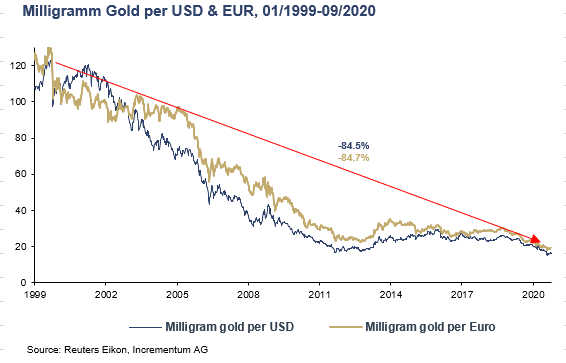
In short: Powell is missing the bigger picture.
At a recent Brookings Institute presentation, for example, a mathematically cornered J. Powell repeated his heroic aim to defeat inflation (which the year before he claimed was “transitory”) and bring CPI levels back toward the carefully-modelled 2% range.
That’s all very Napoleonic, but what a linear-thinking Powell deliberately failed to consider in his tough-talk included some other critical, percolating yet ignored 3-dimensional themes (and alternative/ignored facts) of economic Realpolitik, namely a string of crises (icebergs) relating to balance of payments, fiscal expansion, debt destruction and currency risk.
Free Advice to Expensive Leaders
Perhaps one of Powell’s sub-lieutenants ought to remind him of some of the following tactical considerations (i.e., hard realities) which the Fed has missed in its “blinders-on” effort to defeat inflation via rising rates.
In other words, here’s some free advice and timely reminders of what central bankers like Powell might want to consider, namely:
* US tax receipts (crippled by tanking capital gains from a tanking market thanks to spiking rates) have fallen 11% y/y and getting worse;
* Uncle Sam’s bar tab (USTs, or “IOUs”) is heading toward annual levels of $4-$5 trillion (with a T), which means the global supply of US Treasuries is poised to overtake global GDP growth as bonds tank and yields rise, thus killing everything in their wake except for a temporarily and Frankenstein-strong USD;
* Last month, Federal deficits expanded to record-high levels of $249 billion;
* No one wants Uncle Sam’s debt. The recent auction for 10-Year USTs was a disaster, adding more downward pressure on bonds and hence upward pressure on US yields (above 3.6%) and rates—all of which makes repaying combined US public, private and corporate debts ($90T) one step closer to its breaking point;
* By “tightening” the money supply (QT) to “fight inflation,” Powell has decapitated M2 supply growth (i.e., needed liquidity, lower line below) from 25% to basically 0%– and all he has to show for his linear “war” against inflation is a mis-reported decline in an otherwise misreported and bogus CPI rate from 8% to 7.1%. That’s what historians call a “pyric victory”:
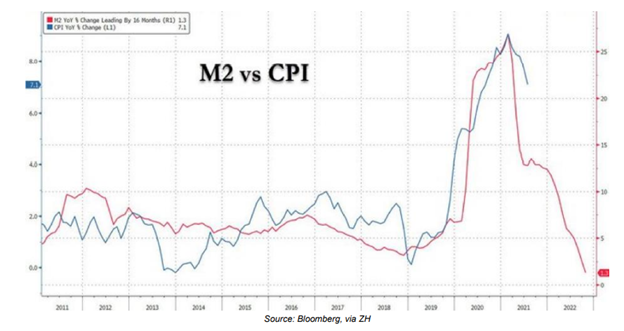
*US Federal deficits are growing at far greater rates than world GDP growth, which means that there is mathematically, empirically, objectively and candidly not enough natural demand for Uncle Sam’s desperate IOU’s to be “bought” unless the Fed re-ignites a money printer (i.e., “pivots”) to absorb/purchase the same. If not, bonds will literally tank and the relatively strong and poisonous USD will move fatally and sharply higher along with rising yields/rates.
American Exceptionalism: A Debt-Soaked Paper Tiger
It seems General Powell has forgotten that the post-08, Fed-distorted (i.e., debt-driven) dystopia of American “exceptionalism” is a nothing more than a financial and economic paper tiger that is highly sensitive to rising rates and tanking markets, making the odds of a U.S. “soft landing” about 0%.
Instead, and as warned all year, the US and global economy is effectively (i.e., already) on its debt-poor knees, and when, not if, we officially arrive at the hard landing of a local and global recession marked by tanking US (and other sovereign) bond markets, global yields will spike “gilt-like” –ushering in a period of global market and economic dysfunction far beyond the pale of anything seen prior.
The Blame Game
It also seems that Powell (like all the other central bankers on the BIS pay-roll which influence all global leaders/puppets) doesn’t like to face bad news until the situation is already too bad to fix.
At that point, it then becomes necessary to blame their financial sins on a flu, a Russian bad guy or a global warming fear campaign.
But what none of these current excuses can hide is the simple fact that our global, fatal and entirely central bank created $300+ trillion debt bubble was in motion long before the current excuses (lies) became the scapegoats for the failures of our central-banking real goats.
The Bond Market is THE Thing
In short, and as we’ve consistently warned for years, “the bond market is the thing,” and when it goes, so does just about everything else.
And by the way: That bond market is dying right before our wide-open eyes.
If this seems hard to believe or “sensational,” just consider what Bank of America already knows, namely that global government bonds are poised to record their 6th worst annual return since 1700. Yes, 1700.
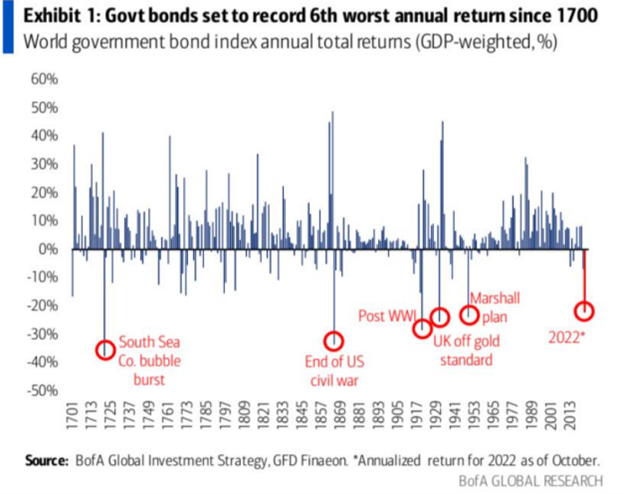
In my view, such bad news for our embarrassing credit markets is only about to get worse, not better.
Why?
Because if US deficits were “just” 32% of global GDP growth in 2022, think what 2023’s bond markets will do when those deficits grow wider—far wider into a new year with even less available global balance sheets to purchase the debt of increasingly bankrupt/broke nations.
Even Blackrock has lost its appetite for sovereign bonds, which, without money-printer support, are nothing more than junk bonds hiding behind well-dressed prompt-readers and absolutely clueless (and increasing cashless) Treasury Secretaries.
The Trillion Dollar Question
So, with all these unwanted, un-supported and unpayable bonds floating around the globe, will the Fed eventually do what the markets have already priced in and thus re-heat the money printers and mouse-clicked Dollars?
In other words, will more inflationary QE come back despite Powell’s public QT ruse to fight inflation?
Failing the anticipated QE pivot and liquidity injection, bonds will tank, which means stocks will tank and the only asset rising before investors’ watering eyes will be an otherwise artificially rising USD.
In short: Should Powell continue with his linear QT model to avoid the inflationary shame and legacy of an Arthur Burns by embracing the fantasy comparison to Paul Volcker, the very “everything bubble” which the Fed alone created will end in a global recession of which the Fed also singularly created.
This is because centralized global markets are now entirely and unnaturally driven by central banks rather than natural supply and demand forces.
Or stated otherwise: The Fed giveth, and the F ed taketh away.
Chaos: It’s Now Inevitable Rather than Theoretical
All things (and hence markets) so rigged, centralized and artificial ultimately result in destruction.
Whether 2023 witnesses more QT, or a resigned and panicked pivot to QE, the end result is the same: Chaos of one form or another is just around the corner.
Either we suffer 1) a deflationary implosion of global risk assets and economies, or 2) an inflationary surrender to more currency-destroying QE.
As I’ve said elsewhere, Powell and the rest of us will have to pick our poison. But in my view, we are likely to see both.
Two Poisons at Work
That is, the one-dimensional and arrogant “modeled” mind of Powell will tighten (de-or-dis-inflationary) until the markets truly break in a backdrop of fatally rising yields and rates.
Then, as if the global economy can be turned up or down like a home thermostat, Powell will throw in the towel and print more fake money (inflationary).
But not long after that critical pivot moment, Powell will discover what most folks in Germany (where energy costs are 12% of economic output) already know, namely: Your thermostat doesn’t work and your left standing in the cold.
Like too much of anything (from martinis to steroids), eventually the stimulus effect of fatally debased, mouse-clicked money fades.
At that point, rather than enjoy the old buzz or high, markets and economies will suffer the puking sensation of a global hangover. Translated to simple speak: Not even more QE will save us.
Again: More chaos, however you look at it.
But what does that mean for precious metals like gold?
Gold Loves Chaos
As I’ve argued throughout 2022, an artificially rising USD has been an obvious headwind to USD-priced gold.
But should the USD rise even further and longer under a fork-tongued Powell, and even if the DXY resumes its bumpy gyrations south and then north again, not even a stronger Dollar (or rigged COMEX market) can keep gold forever repressed.
This is because a too-strong USD under continued Powell tightening will expand the aforementioned deficit levels and GDP growth ratios to a breaking point which cripples credit markets, destroys equity markets and knee-caps economies.
When this happens, faith in the system, as well as the individuals who run them, will rightfully disintegrate faster than SBF’s weird sex life.
It is precisely at such moments of lost faith, as I recently discussed with Grant Williams, in which gold shines brightest.
Alternatively, should Powell try to restore illiquid markets with a pivot toward more QE, the net result will be an inflationary and historic tailwind of currency debasement which will send gold in an equally northern direction.
Most Still Trust the Wrong Things
Despite such undeniable pressures on stocks and bonds, investors still think bonds will save them, especially once the Fed inevitably (who knows the date?) resumes its artificial support of the credit markets.
This might explain the bemused observations of our colleague and advisor, Ronni Stoeferle, who recently tweeted that investors remain the most underweight commodities relative to bonds since April of 2009.
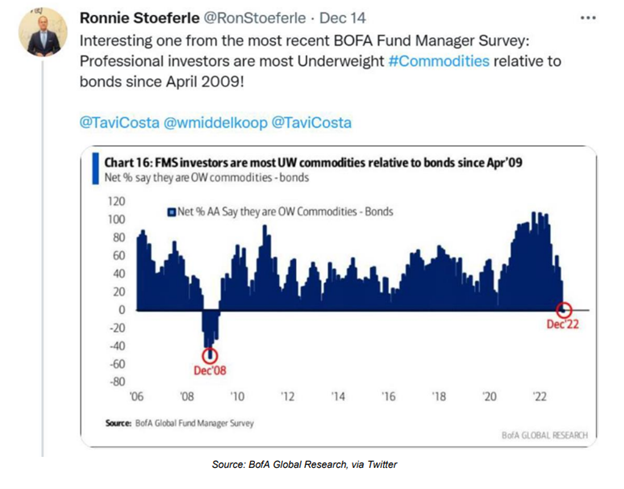
Sadly, such misguided investor behavior is often a superior contra indicator in times of percolating market stress, as most investors run to the wrong assets at precisely the wrong time, a phenomenon we’ve seen at the edge of every market bubble from the NIKKEI in the late 80’s to MBS in 2008.
But let’s not poke fun at the wrong-headed behavior of retail investors when there’s so much more to learn from the wrong-headed behavior of our policy makers and sovereign leaders.
Please: Don’t Trust the “Experts”
As I wrote long ago (even before the insanity of a global lock-down, the corruption of a crypto exchange and the comic tragedy of an avoidable war with–and sanctions against—Russia), we would all be better served trusting our own judgement and objective facts rather than the self-interest and invented facts of our so-called elites.
That is: It’s not always wise to trust the experts and their so-called “models”—be they economic, political or scientific.
Yes, lofty titles and superior educations are attractive and seductive.
The best educations, after all, were at least ostensibly designed (once upon a time) to teach critical thinking and the capacity to challenge rather than blindly follow historical models which no longer work.
But such educations, and such critical thinking, are entirely wasted on the uncreative, the “post-modernist” corrupt and the consensus-driven.
As stated above, uber-Keynesian US financial leadership (entirely ignorant to the debt lessons of the Austrian School) is the product of old models and PhD themes shared among a cabal of policy makers wandering the campuses from Cambridge and Chicago to NYC and Stanford with an eye toward public safety in numbers and private self-promotion from the inside.
This explains the small (and profoundly self-interested) thinking of Treasury Secretaries like Summers or Yellen, the Ignoble Prizes awarded to figures like Bernanke or the confusion of cornered Fed Chairs like Powell.
They simply won’t admit the failures of their career-enhancing models…
Thanks to years of confusing unprecedented debt with economic growth, and decades of replacing sound money with mouse-clicked money, our global credit and equity bubbles are now morphing into their final gasps of currency bubbles already popping in every corner of the globe but for the U.S. and its currently strong but otherwise doomed USD.
But that bubble too will do what all bubbles do: Pop.
And when (and as) it pops, now and in the months ahead, gold will do what it has always done: Provide loyal currency support for systems destroyed by disloyal leadership.
Powell’s Gettysburg Moment, the USD’s Waterloo & Today’s Open Madness
Below we track years of desperate yet deliberate central bank bubble creation (and can-kicking) to its ultimate end-game: titanic currency destruction.
The Bond Market is the Thing
When tracking markets and asset classes, one eventually accepts the Shakespearean reality that “the bond market is the thing.”
When a completely distorted global financial system is driven exclusively by the greatest credit bubble (and hence crisis) in history, the cost of that debt (i.e., the interest rate) becomes a primary protagonist.
When rates are low, for example, bubbles grow. When rates are high, they pop.
Of course, the bigger the bubble, the more fun the ride up; but conversely, the bigger the bubble, the more painful the pop.
And by the way: All bubbles (tech, property, credit and currency) pop.
We are now entering that pop-moment, and the central bankers know it, because, well: They created it…
Once Upon a Time—Natural Forces
Once upon a time, there was a concept and even a dream of healthy capitalism and natural market forces in which bonds were fairly priced on the basis of a now extinct concept once known as natural supply and demand.
Nod to Adam Smith.
That is, when demand for a bond was naturally high, its price rose and its yield (and hence rate) was naturally low; conversely, when demand was low, its price fell and its yield (and hence rate) rose.
This natural ebb and flow of yields and hence interest rates kept credit markets honest.
As rates climbed and the cost of debt rose, debt liquidity naturally slowed down and the system prevented itself from over-heating.
In essence, the bond markets had a natural pressure gauge which triggered a natural release of the hot air within a bubble.
Then Came the Un-Natural and the Dishonest
Then came the un-natural central bankers against which our founding fathers and Constitution warned.
Like everything centralized and human, as opposed to natural, these short-sighted bankers ruined, well: everything.
Rather than allow bonds, yields and hence rates to be determined by natural price forces, these banks had the arrogant idea that they could control such forces, the hubris equivalent of a sailor attempting to control the powers of an ocean.
Nod to John Smith of the Titanic.
The Fun Part
For years, central bankers have artificially supported sovereign bond markets by purchasing otherwise unwanted bonds with money created out of thin air.
This absurd yet popular “solution” of repressed rates created bubble after bubble. That was the fun part.
It is also the part which breeds a school of academic apologists and theories (nod to MMT) who justify and defend the same as an unsinkable market.
Remember Janet Yellen’s claim that we may never see another recession? Or Bernanke’s Nobel-Prize winning observation that we could print trillions at “no cost” to the economy?
Meanwhile market participants, enjoying the tailwinds of low rates and easy/cheap access to debt, ignore the bubble dangers (i.e., icebergs) ahead as they enjoy the admittedly fun part of a rising bubble.
And oh, what fun a cheap-debt-driven and artificially controlled series of cheap-debt-induced bubbles can be…

Like the tuxedo-clad 1st class passengers on the Titanic’s A-Deck, investors (the top 10% who own 90% of stock market wealth) pass cigars and brandy among themselves and speculate like children comparing portfolios, all the while ignoring the rising iceberg off the bow.
How Icebergs Are Made
When it comes to making icebergs, our central banks have a perfect record, and the leader of this pack is the U.S. Federal Reserve, a private bank which is neither Federal nor a reserve.
Just saying…
For those paying attention rather than passing cigars on the A-Deck, you’ve already noticed this pattern of bubble-to-bubble and hence debt iceberg to debt iceberg creation before.
The Fed, with the complicit support of the commercial bankers and policymakers, for example, “solved” the tech bubble of the late 90’s (kudos to Greenspan) which popped in 2000 by creating a real estate bubble which popped in 2008.
Through the same playbook of artificial rate suppression, the Fed then “solved” that housing bubble (kudos to Bernanke) by creating a global sovereign debt bubble/iceberg (kudos to Yellen and Powell), the very A-Deck upon which we all stand today.
Today’s Iceberg: A Global Credit Crisis
Having bought time and bubbles, from tech to housing to sovereign bonds, the Fed is now running out of places to hide its latest iceberg. This kind of can-kicking is more like sin-hiding.
Having squeezed a tech bubble into a real estate bubble, and then a real estate bubble into a sovereign debt bubble, where can the central bankers now hide their latest Frankenstein, bubble and iceberg? (I love metaphors.)
The Currency Bubble
For me, at least, the answer is fairly clear.
The only way to hide and “solve” the greatest sovereign bond iceberg (crisis) in history is to bury it beneath wave after wave of mouse-clicked, debased and hence increasingly worthless fiat currencies.
In short, the Fed will hide its latest credit bubble behind the last and only bubble it has left in a history-confirmed pattern used by all failed financial regimes, namely: Creating a currency crisis (i.e., debased money) to solve a debt crisis.
Of course, if you read that last line (as well as centuries of economic history) correctly, this just means there are no solutions left, just a choice of crisis options: drowning bonds or drowning currencies.
Pick Your Poison: Credit Crisis or Currency Crisis
Just like the officers at the wheel of the Titanic were the first to realize their ship was sinking, the central bankers from DC to Tokyo are equally aware that they were driving too fast in a sea of icebergs.
Now, they are struggling to “be calm” in voice as their crew scurries to count unavailable lifeboats and keep the passengers from panicking too soon.
Among this crew of policy sailors on the financial Titanic, two camps are forming. After all, even when a ship is sinking, there is always different expressions of the human instinct to survive.
One camp is hawks. The other camp is doves. In truth, however, both camps are doomed.
Hawks Squawking
The hawks are telling the passengers (investors) to fear not.
Yes, they are raising rates to fight inflation, but this, they calmly say from the shivering A-Deck, will not cause the global credit and hence financial markets to sink into a contagious recession/depression.
This is the camp of Larry Summers, William Dudley, Jerome Powell and the likes of James Bullard at the St. Louis Fed.
Bullard, for example, thinks a Fed Funds Rate of anywhere from 5% to 7% may lead to a mere “slowdown in growth” but by no means a recession.
Well, that’s rich. This coming from the same office that said inflation was “transitory” and a recession is not a recession.
Based on prior GDP prints and the inverted 3m/10y yield curve inversion of late, I’d argue we are already in a recession, but then again, why let facts get in the way of a good lifeboat narrative.
As the Fed captains all know, when the truth hurts, just lie.
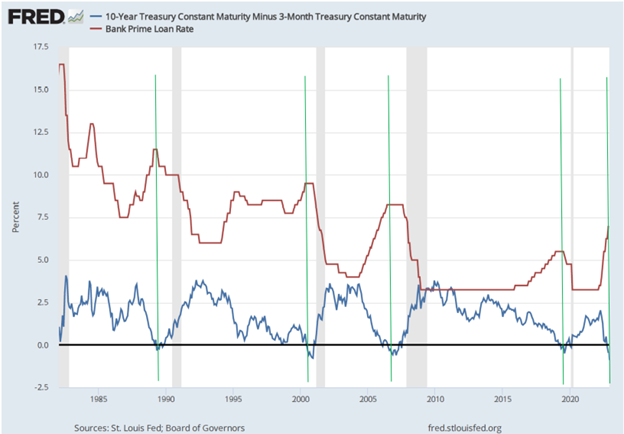
The hawks, it seems, somehow believe that they can raise rates (to as high as 7%) to kill mis-reported inflation (as high as 16%) [???] without killing the credit market.
Hmmm…
At the same time, however, Powell needs inflation to outpace interest rates to achieve a deep enough slope of negative real rates to inflate away the USA’s $31T public debt.
Like Captain Smith on the Titanic, Powell is trying hard to stay calm but knows the end game.
Dead Market or Dead Currency?
In short, Powell is in the mother of all conundrums, dilemmas and self-made corners. He literally has no good options left.
If he keeps raising rates to “fight inflation”—he risks sending the global credit markets below the cold-water line.
But if he pivots, eases or allows more liquidity (i.e., QE) back into the bond markets, he saves the bonds but kills/debases the currency and hence creates more rather than less inflation.
Again. Pick your poison: A dead bond market or a dead currency?
The Choice Has Been Made
But in case the suspense is killing you, I’d say the answer is already in front of us.
As hinted above (and shown below), the only and last option left for debt-soaked regimes is currency debasement.
History proves time after time after time that there are no exceptions to this sad rule.
Despite his words to the contrary, Powell will ultimately be forced to kill the currency to allegedly save the credit markets—thus once again squeezing one bubble (in credit) into another bubble (currency), which is what all the central bankers have been doing for years: Pushing one bubble into the next until the final one pops.
Stated otherwise: There just aren’t enough life boats for Captain Powell’s financial Titanic.
Facts Speak Louder Than Words
As I’ve argued all year, Powell may talk Volcker-tough, but he’s moving toward more fake liquidity and hence more inflationary money printing.
If you think otherwise, the evidence is already before us—and I’m not just talking about “moderating the pace of rate hikes.”
In order to survive, the credit markets need more balance sheet expansion (i.e., QE), which by definition, is inherently inflationary.
Nod to Milton Friedman.
Again: Powell will choose inflation (and currency debasement) over “fighting” inflation, because Powell secretly needs inflation and negative real rates to inflate away Uncle Sam’s bar tab.
Nod to Stan Fischer.
This eventually means letting the USD expand in supply and hence sink in value.
Or stated simply: A currency crisis.
Just Follow the Pattern/Banks
Toward this end, the other major central banks and currencies of the world are already doing this.
The yen, euro and pound of 2022, for example, have sunk to record lows to monetize local debts—the USD will eventually follow in 2023.
In fact, this unspoken preference for liquidity over “inflation fighting” is already evident rather than speculative.
As per the chart immediately below, November saw $45B in Treasury spending and another $139B in repo liquidity—for a total of 131B in net liquidity into the market, a number which far overshadows the $53B of so-called “QT” tightening by Powell.
In short, one may speak like a hawk but act like a dove.
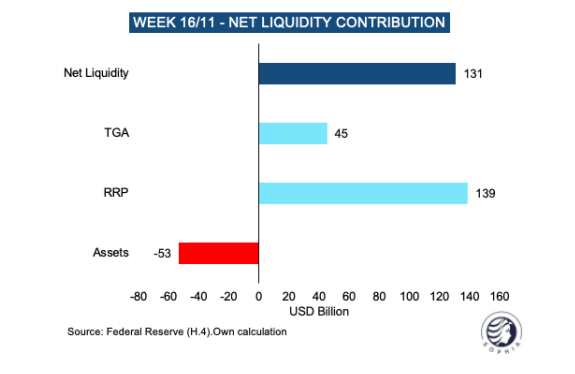
Meanwhile, stocks and bonds were falling together.
Can we all say: “Uh-oh”?
As per the bars at the far right of the graph below, for the 1st time in 60years, we saw a UST market (blue bar) fell faster and further than a top-20 stock market drawdown (grey bar).
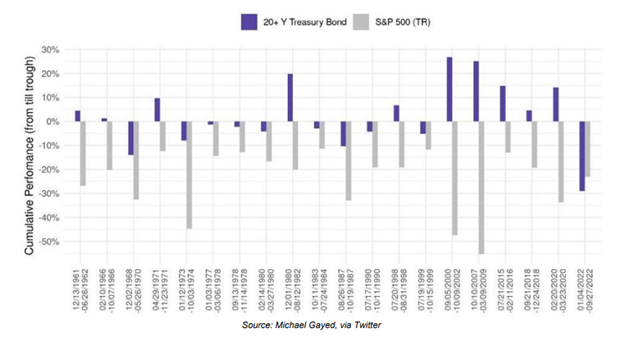
Hmmm. Can we blame this historical fall in USTs on inflation?
Nope.
In the 1970’s, and as per chart above, we saw inflation, but never USTs (blue bar) falling further than stocks.
Why the critical difference today?
Easy. Bonds are falling in price because demand is falling in fact. This bond drop is not because of inflation, but because no one trusts the debtor—i.e., Uncle Sam.
Unlike the 70’s, US debt to GDP today is at 125+%, and thus American IOUs today just aren’t what they were yesterday.
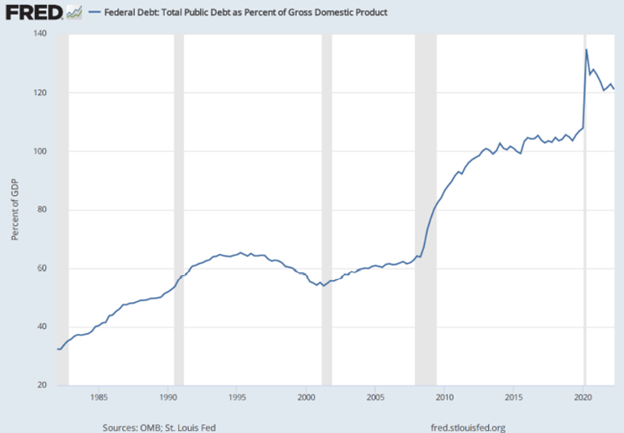
…and fiscal deficits are at 10% of GDP.
That’s what I call a debt iceberg…The bigger it gets, the lest investors trust the debtor beneath the surface.
Toward this end, foreign banks are turning their backs on Uncle Sam’s unloved USTs (IOUs)…
Frankly, I’ve never seen such a grotesque convergence of debt icebergs heading for our economic bow.
Watch the Currencies—They’re Already Drowning
As global central banks debase their currencies (yen, euro and pound) to monetize their unloved and unpayable sovereign debts/bonds, we can expect more volatility in the FX markets and pairings as the current USD, like the bow of the Titanic, rises temporarily high above the waves before sinking deep, deep below them.
Can the Fed save that sinking dollar/Titanic by cranking up rates ala Powell at the expense of the US economy and markets as well as at the expense of its global friends and enemies who can’t pay back $14T worth of USD-denominated debts when the USD is too expensive?
I think not.
Nor am I alone in calling out this impossible dilemma of bad options and bad bonds. Druckenmiller and Dimon are saying the same thing.
Stated simply, the only way current central banks can keep their unloved bond market afloat is by drowning their currencies in more QE, which, needless to say, will be very good for gold…
This QE (currently hiding in the ignored repo markets) will be the last resort until the widely telegraphed and pre-planned “great [disorderly] reset” toward CBDC becomes the next embarrassing reality.
This collective lack of faith in USTs and USDs is why global central banks are swapping out USTs and buying physical gold…
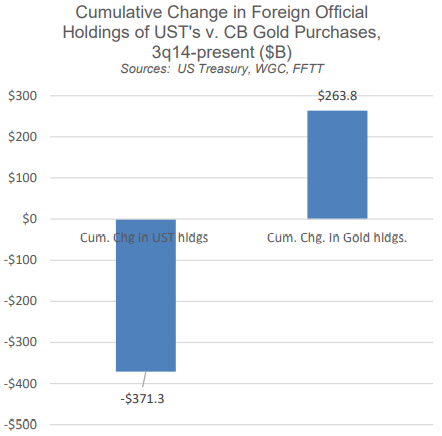
As I’ve written and said before, it’s hard to imagine how we ever got to this obvious consequence of too much debt and too much artificial, centralized “capitalism.”
Were policy makers sinister (i.e., intentionally creating a red carpet toward CBDC and more total control) or just irretrievably stupid?
Either way, the end result is the same: The global financial system will sink, and though the USD may be the last to go under, under she will go.
Powell’s Gettysburg Moment, the USD’s Waterloo & Today’s Open Madness
Gold’s price direction is explained below.
From polo to hockey—it’s a known fact that the best players think three moves ahead.
Sadly, the same can’t be said of our financial elites…
But as playing conditions deteriorate across the bond, stock, property and currency markets, those with a “three-play- ahead” mindset will have the greatest advantage.
This is especially true for precious metal investors, regardless of their riding or skating skills 😉.
More Horse-Droppings from the Treasury Dept
One of the most important global players on today’s macro pitch is the credit market, and that horse is tired.
Last week, former Fed-Chair-turned-US-Treasury Secretary, Janet Yellen, told reporters that her office is “very focused” on Uncle Sam’s IOUs, and even confessed “concern” regarding “episodes of illiquidity” wherein it has been difficult to buy or sell US Treasuries, especially in large amounts.
Ultimately, however, the mule-riding Don Quixote, Janet Yellen, does not “see problems at this point in the U.S. Treasury Markets.”
Ahhhhh. That’s rich….
Apparently, Yellen has a very poor eye for the current playing field and is chasing windmills rather than the rules of a moving target.
Hiding Bond Liquidity with Verbal Liquidity
As we have been warning for months, these “episodes of illiquidity” are more than just a “concern.”
In fact, they serve as undeniable evidence that the world is running out faith in Uncle Sam’s bloated bar tab after years of monetary addiction to mouse-click money to pay for (monetize) the so-called “American way.”
In short, when GDP, tax receipts and good ol’ fashion productivity or trade surpluses no longer work, the US has become good at just borrowing and printing, a tactic (i.e., charade) that bought time, votes and even an appallingly ironic Noble Prize for Bernanke, but a ruse for which the rest of the world is now losing faith after years of importing American inflation.
In short, more and more of the world wants less and less of Uncle Sam’s sovereign debt, which means USTs are falling and hence yields and rates are rising.
And as previously reported, those rising yields are like rising shark fins approaching a debt-soaked global system already bleeding in the water.
Stated simply, when Yellen says she sees no problems, that’s precisely when you know there’s a problem.
Or as Otto von Bismarck (and Tree Rings) reminds: “Never believe anything in politics until it is officially denied.”
More Treasury Secretaries, More Mules Masquerading as Thoroughbreds …
Speaking of Treasury Secretaries (i.e., the worst players on the “cancha”), former Secretary Larry Summers is doing what he does best, namely: Causing problems behind the scenes (from repealing Glass Steagall to deregulating derivatives), denying/ignoring guilt, and then once those problems become obvious, making public warnings of the same to appear virtuous.
Like Minister Fouche under Napoleon, Summers blows in which ever direction the wind most suits his image.
Toward that end, he’s finally speaking of what most of us have known long ago: The US can’t afford rising rates in 2022 under Powell the way it could in 1980 under Volcker.
Thanks, again, Larry, for jumping on the band wagon long after it’s too late.
Given the foregoing realities, double-speak and just plain dumb out of DC’s lowest-goal but best-dressed players, the inevitable consequences of unloved Treasuries as a result of unimpressive Treasury Secretaries simply means an inevitable pivot toward more printed, debased and inflationary Dollars to keep Uncle Sam from defaulting on his bonds.
But politicians are clever foxes. They hide their addictions (and intentions) as cleverly as the BLS hides inflation facts.
Just More Backdoor QE Before the Real Thing
Just like politicos can deny a recession in a recession or deny inflation during inflation, they can pretend that QE is not QE, even when it is, well… QE.
Toward that end, we can expect the Treasury Department to start buying its own longer-dated bonds (USTs) by swapping them with shorter duration T-Bills.
Officially, this is not Quantitative Easing per se, but rather a “UST buyback.”
But why let fake semantics confuse honest math? The smart players are already three plays ahead of the Fed’s empty rhetoric and bad riding skills.
Like the daily repo support from the Fed, in the end, such “buyback” schemes are just QE under a different mask.
Powell’s Ruse Continues
Thus, as such shell games in DC continue to hide reality behind words, the Powell Fed will continue its ruse to fight inflation the “Volcker way” and likely announce and conduct additional (but 50 rather than 75 bps) rate hikes in the last chapters of 2022 and the early chapters of 2023 before the inevitable surrender to more QE.
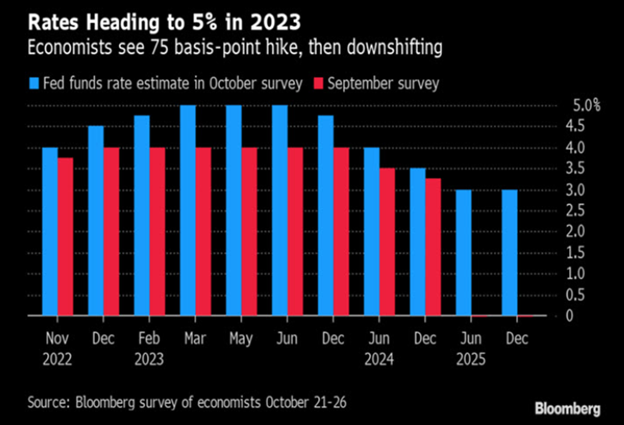
Why the near-time rate hikes?
Powell knows that when the current recession becomes an official recession, he’ll need at least one tool in his ever-weakening toolbox.
In short: He’s only raising rates today so that he’ll at least have something to cut tomorrow.
And speaking of recession, the following (and inverted) yield curve is a screaming sign that a recession is coming, if not already here.
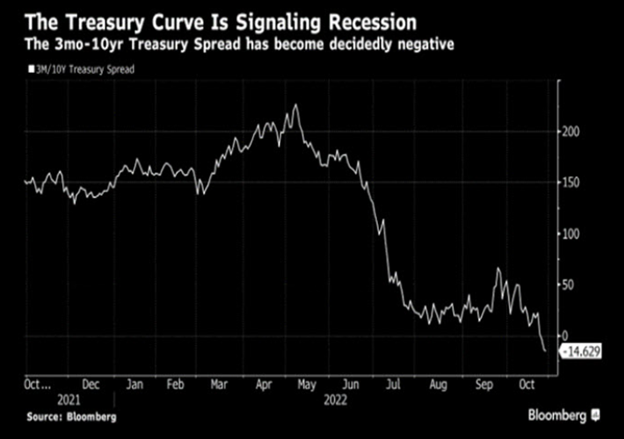
I See Serious Stagflation Ahead
As for fighting inflation, any short-term hopes of beating inflation will end once the money printers are spinning again at full speed to buy Uncle Sam’s increasingly unloved IOUs.
This will likely occur in 2023, but frankly, who the hell knows precisely when it will rain QE money? I don’t.
The key is recognizing the shark fins and getting a safe boat. And as warned previously, we are all gonna need a bigger boat.
Stated bluntly and simply, there’s no way to ever unwind the Fed’s balance sheet nor the nation’s $31T deficit in the face of a recession that will take that deficit many, many, many trillions higher.
These obvious and fatal inflationary realities will ultimately collide with the disinflationary forces of a long and painful (as well as Fed-engineered) recession.
Given that I see inflation as a monetary issue rather than just a bogus CPI print, the further and inflationary debasement of the USD under further QE ahead (despite the USD’s growing and ironic relative strength) will be a stronger force than a deflationary recession.
In simple terms, this means we need to prepare for (rather than debate) some serious stagflation ahead.
Toward that end, and as already implied by a number of DC insiders, we can expect the Fed to slowly alter its “target inflation” narrative from the comical 2% range to an equally comical 4% or higher range in the coming months and quarters—all of course, to be blamed on Putin or COVID rather than years of mouse-click money.
Powell, like most mediocre politicians (or polo players), is ego driven rather than Main Street responsible. His main fear today is not about keeping his post, but assuring his legacy.
Secretly, Powell fears looking like another Arthur Burns, who let inflation get too hot. Thus, Powell’s public image today is about fighting inflation.
But I’m not buying it. The real goal today is to inflate away debt.
Karma’s a B!7@#
In reality, and to repeatedly shout from the rooftops, the only way to handle $31T in US public debt is to “inflate it away” by eventually loosening rather than tightening monetary policy once it becomes obvious that US IOUs won’t find enough buyers unless there’s a money printer to do so.
Needless to say, such grotesque reliance on a money printer (i.e., money killer) is the economic Karma of far too many years living on debt rather than productivity, and far too many years of the US exporting its inflation to the world and clipping the wings of their own allies by making the USD too strong to repay, settle or compete.
By 2024, I expect a disorderly “reset” and central bank digital currencies as the USD loses what little respect it has left.
The World Turning a Slow Back on a Fast Dollar
Toward this end, and as forewarned too many times to count, the rest of the world (I.e., the BRICS) is either turning away from the steroid-ruined USD (slowly but surely) or turning toward their currency-debasing money printers (think Japan and the UK yesterday and the ECB and the Fed tomorrow).
Meanwhile, Saudi Arabia is looking more toward China and less toward Biden to improve energy cooperation.
As warned, the Petrodollar system, so critical to the USD’s eminence (i.e., forced demand) in the world, is going to slowly unwind as Saudi starts accepting yuan rather than USD for its oil.
So yes, the world (and Dollar) is changing, and fast…
Poor Germany
Over the weekend, for example, I was in Munich, where inflation is already at 11.6% in a country which is considered Europe’s most reliable creditor.
But even Germany can’t seem to find any buyers for its bonds as Olaf Scholz scurries to raise $200B to pay for rising energy costs due to its blind (forced?) support for American sanctions against Putin in yet one more example of a long list of U.S. proxy wars on other peoples’ land.
But who wants to buy a German bond when the inflation rate is running some 900 basis points above the average interest rate, which means buyers lose almost 9% of their return to inflation the moment they bid?
In short, the reality of negative real yields (the hidden trick of all broke nations) is not only hitting the face of the average US citizen, but Germany’s as well.
Gold: Play the Direction of the Ball
As introduced above, all of these trends point not to where the golden polo ball or hockey puck sits currently, but toward where the ball or puck is headed…

Right now, and as explained at length elsewhere, an engineered and only relatively strong USD is taking the shine off gold. The current inverse correlation between gold and the USD is undeniable.
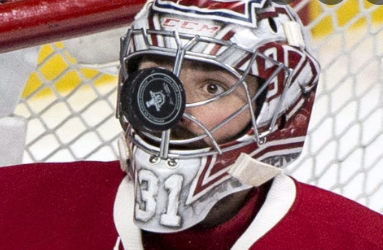
But that is where the ball sits now. Where it is headed is another matter, and great players, as well as investors, are always three plays ahead of the moment…
Stated more simply, as more and more currencies (including, yes, even the USD) weaken in a backdrop of inflationary realities and debasing consequences, gold is headed for an historical move, which means central bankers are about to get hit with a golden puck…
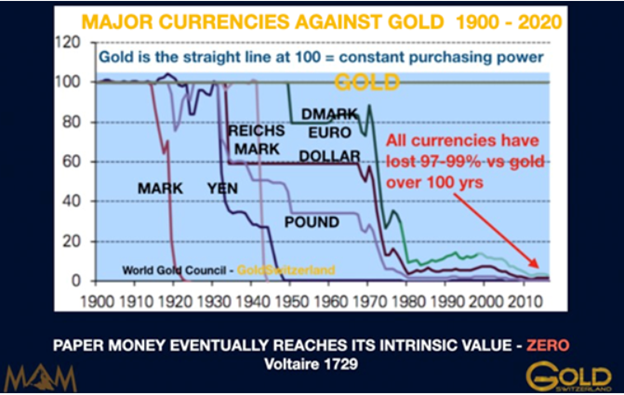
Toward this end, investors around the world are always asking Egon and I what the gold price will be in a month, a day, a year etc.
But gold price measured in what? In USD? Yen? Euros? Pound Sterling?
Folks, the simple point is why measure a fixed asset in an increasingly dying currency? Gold’s real measure is in ounces and grams, not fiat paper.
Or stated more simply: Gold doesn’t rise (see flat/constant top-line in graph below), it just holds its value as fiat currencies gyrate and then die like a fish flopping on the dock, which all fiat currencies have always done, throughout history, every time and without exception.
So, are you playing the ball where it lies now, or where it will be three plays ahead?
Powell’s Gettysburg Moment, the USD’s Waterloo & Today’s Open Madness
Below we track how the Powell Fed serves as a contemporary weapon of mass destruction.
Powell’s so-called “war against inflation” will fail, but not before crushing everything from risk asset, precious metal and currency pricing to the USD. As importantly, Powell is accelerating global market shifts while sending a death knell to the ignored middle class.
Let’s dig in.
The Fed: Creators of Their Own Rock & Hard Place
In countless interviews and articles, we have openly declared that after years of drunken monetary driving, the Fed has no good options left and is literally caught between an inflationary rock and a depressionary hard-place.
That is, hawkishly tightening the Fed’s monthly balance sheet (starting in September at $95B) while raising the Fed Funds Rate (FFR) into a recession was, is and will continue to be an open head-shot to the markets and the economy; yet dovishly mouse-clicking more money (i.e., QE) would be fatally inflationary.
Again, rock and a hard place.
What’s remarkable and unknown to most, however, is that the Chicago Fed recently released a white paper during the Jackson Hole meeting which says the very same thing we’ve been warning: Namely, that Powell’s WMD “Volcker 2.0” stance (arrogance/delusion) is only going to make inflation (and stagflation) worse, not better.
To quote the Chicago Fed:
“In this pathological situation, monetary tightening would actually spur higher inflation and would spark a pernicious fiscal stagflation, with the inflation rate drifting away from the monetary authority’s target and with GDP growth slowing down considerably. While in the short run, monetary tightening might succeed in partially reducing the business cycle component of inflation, the trend component of inflation would move in the opposite direction as a result of the higher fiscal burden.”
In short, Powell can’t be Volcker.
Why?
Simple.
America Can’t Afford Powell (or His Rate Hikes)
This hard reality is economic and mathematical, not political or psychological, though Powell suffers from both political delusion and a psychological lack of self/historical awareness…
I’d like to ask Powell, for example, how the US plans to pay for its now rate-enhanced (i.e., even more expensive) debts and obligations regarding defense spending, Treasury obligations, social security and health care when just the interest payments alone on Uncle Sam’s current bar tab are unsustainable?
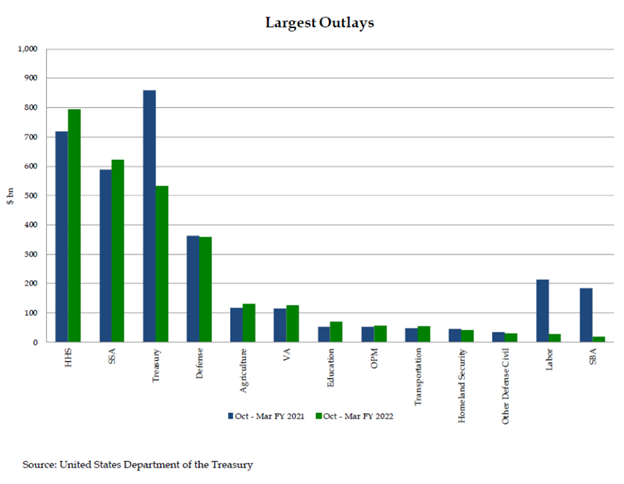
Powell, part of the so-called “independent Fed,”will now have to make a political choice (and trust me, the Fed IS political): Will he A) intentionally seek to crash the economy into the mother of all recessions to “fight” the inflation his own private bank’s balance sheet singularly created, or B) will he help turn America into the Banana Republic that it is already becoming by printing (debasing) trillions more US “dollars”?
The “inflation-fighting” Powell, embarrassed to go down in history as the next Arthur Burns, may just A) continue to hike rates and strengthen the USD (currently bad for gold), which is sending America to its knees, or B) sometime this autumn he’ll cave, pivot and let inflation rip (while the BLS, of course, under-reports inflation (i.e., lies) by at least ½).
In the meantime, we can only watch markets and economic conditions continue to tank as interest rates and the USD climbs toward a peak before the USD makes a record-breaking fall.
And why do I see a fall?
Easy.
The Credit Markets Are Screaming “Oh-Oh!”
To borrow/twist from Shakespeare: “The bond market is the thing.”
Everything, and I mean everything, hinges on credit markets. Even the cancerously expanding US money supply(M0-M4) is at root just 95% bank credit.
Understanding credit markets is fairly simple. When the cost of debt is cheap, things (from real estate to growth stocks) feel good; when the cost of debt is high (as measured by the FFR, but more importantly by the fatally rising yields on the US10Y), things collapse.
We saw the first (and media-ignored) warnings of this collapse in September of 2019 when the oh-so critical (yet media ignored) repo markets imploded, none of which can be blamed on COVID (2020), Putin (2022) or climate change.
As dollar liquidity dries up, so will markets, economies and lifestyles. Remember: All market crises are, at root, just liquidity crises.
A Summer of Credit Drought
As previously warned, signs of this drying liquidity are literally everywhere. The Fed’s own Quarterly Loan Officer Survey confirms that banks are lending less.
And given that 70% of the US bond market is composed of junk, high-yield and levered loans (i.e., the worst students in the class hitherto priced as PhD candidates), the rigged game of debt roll-overs and stock buy-backs is about to end in a stock and bond market near you as rates rise to unpayable levels.
Furthermore, it’s worth noting that US banks (levered 10X) and European banks (levered 20X due to years of negative nominal rates), will now use rising rates as the long-awaited excuse to de-lever their bloated balance sheets, which is fatal to risk asset markets.
Even more alarming, however, is what this de-leverage will mean to that massive, USD-based and expanding (1985 to now) Weapon of Mass Destruction otherwise known as the OTC and COMEX derivative markets.
Rather that expand, this fatal market will contract—all of which will have massive implications for the USD as debt markets slowly turn from a past euphoria to a current nightmare.
The Dangerous USD Powell Ignores
Measured by the DXY, the Dollar is ripping.
But you’ll note that Powell and his “data points” never address the Dollar.
Powell, like most DC-based Faustian deal-makers, lives in a US-centric glass house, which ignores the rest of the world (namely Emerging Markets, oil producers and mislead “allies”) who are de-dollarizing (i.e., repricing the USD) as I type this.
In case Powell never took an econ history class or read a newspaper that was not written in English, it might be worth reminding him that EM nations like Venezuela, Lebanon, Argentina, Turkey, and Sri Lanka, as well as, of course, the BRICS themselves, are tired of importing US inflation and paying trillions and trillions of Dollar-denominated debt or forced dollar-settled oil purchases.
As the Fed artificially strengthens the USD via rate hikes, debt-soaked nations are forced to either: A) debase their currencies to pay their debts (which might explain Argentina’s 69.5% official interest rate) or B) raise rates and look elsewhere for new trading partners or money.
Even “developed” economies are seeing their currencies at record lows vis-à-vis the rising USD (Japanese Yen at 50-year lows, UK’s currency at 37-year lows and the euro now at 20-year lows).
And as for those cornered EM nations, $650B of the IMF’s 2021 usurious (and dollar-based) loans to them have already dried up.
EM Markets Looking East Not West
So, where will EM countries go trade, survival, better energy pricing, and even fairer gold pricing?
The answer and trends are now open and obvious: East not West, and away from (rather than toward) the USD.
Russia and China are making trade and currency deals not only with the BRICS at a rapid pace, but with just about every nation not otherwise “friendly” (i.e., forced to be) with the USA (and which “friends” now face a cold winter on this side of the Atlantic.)
Even the notoriously corrupt LBMA gold market, which spends its every waking hour using forward contracts to artificially crush the paper gold price, is about to see a Moscow-based new gold exchange (the Moscow Gold Standard).
Of course, such a Moscow exchange makes sense given that 57% of the world’s gold comes from Eurasian zip codes where a post-sanction Putin sees yet another golden opportunity to fix what the West has broken.
Furthermore, and as stated above, as the derivatives markets de-lever, demand for the USD (and hence dollar-strength) will equally tank, as OTC settlements are done in USD, not Pesos, Yen, euros or Yuan.
As we warned within weeks of the failed sanctions against Putin, the world is de-dollarizing slowly yet steadily, and once the DXY inevitably slides from 108, to 107 and then below 106, the Greenback’s fall will mirror Hemingway’s description of poverty: “Slowly then all at once.”
For the last 14 months, the Dollar Index has been trading above its quarterly moving average, which as the always-brilliant Michael Oliver reminds, is like a runner who never exhales. At some point the USD’s lungs will collapse.
Gold: Waiting for the USD to Snap
The foregoing and seismic shifts in the derivative and EM markets portend the sick finale of the USD, and hence for the currently repressed gold price. In short: As the former tanks, the latter surges.
Many are nevertheless angry that gold hasn’t ripped in a world of geopolitical risk and rising/persistent inflation, but that’s because the artificially rigged USD has been their only (and short-lived) measure.
As risk assets in the US and around the world experience double-digit declines, gold in every major currency but the USD has been rising, not falling:
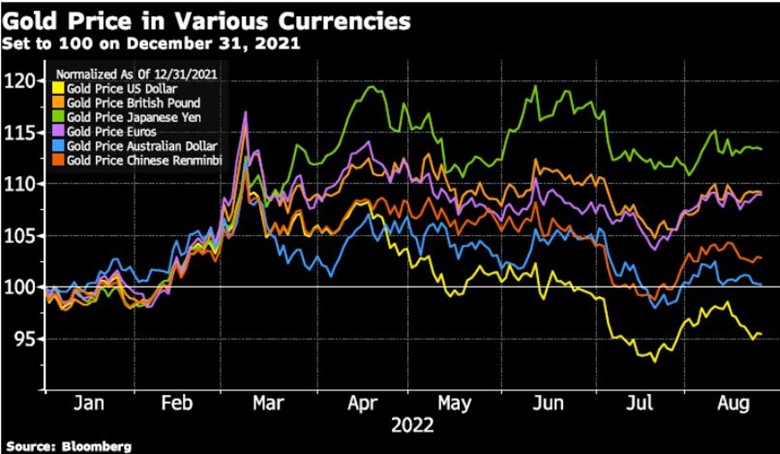
And even gold’s relative decline in US markets remains minimal compared to double-digit losses in traditional US risk-parity (i.e., stock/bond) portfolios for 2022.
A COMEX in Transition
You also may have overlooked that those fat foxes over at the BIS recently unwound 90% of their gold swaps (from 500 to 50 tons) at precisely the same pace that JP Morgan and Citibank (which hold/control 90% of the US commercial banking gold derivatives) just expanded the notional value of their gold derivatives by 520% (!).
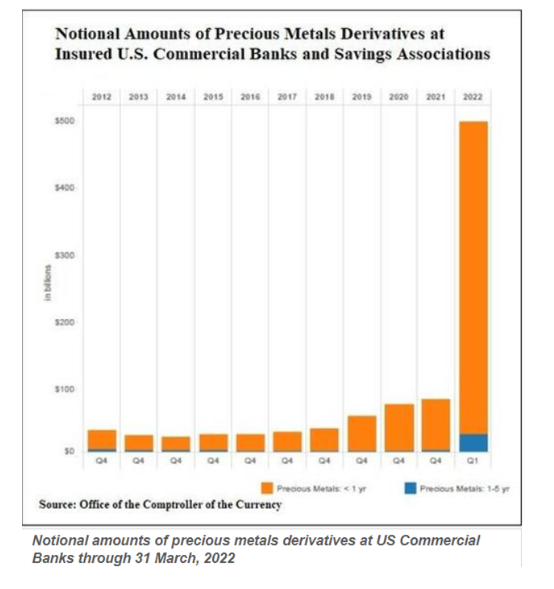
Anyone and everyone in the precious metals markets knows that the notional value of those contracts over-shoots the actual supply of the physical metal by 99%.
The COMEX is a nothing more than a legalized fairytale (fraud) whose non-fictional pains (and gold surges) are inevitable.
In the meantime, however, many players in the COMEX markets (the precious metal exchange in NY) are now (and increasingly) looking to take delivery of real rather than paper gold.
Why?
Because they see the writing on the wall.
Gold is a monetary metal not a paper card trick. The COMEX players want to get as much physical metal as they can before false idols like Powel and the global EM currents flowing East take down the USD’s post-Bretton Woods hegemony.
When/as that happens, gold does what it always does when nations and their debased currencies tank: It rises.
And you can be sure that JP Morgan and Citi will keep the paper gold price low until they have enough of the physical gold in hand when gold rips and the USD sinks.
For Now, More Lies, Empty Phrases and Distractions
In the meantime, Powell will act like the nervous captain of a sinking ship and play with rates and the USD as the DC information bureaus (i.e., BLS) spread more open fictions and false distractions on everything from the inflation and unemployment rate to suddenly forgotten viral threats (?), the freedom of Ukraine or the political theme of climate change.
And of this you can also be certain: Powell will continue the Fed’s historical role of crushing the US working class.
Translating Powell’s “Softening Demand”
As Powell wandered Jackson Hole, he warned Americans to prepare for “softening demand,” which is a euphemism for crushing the middle class via rising rates and long-term (rather than “transitory”) inflation ahead.
This rich.
After being the sole tailwind for pushing equity markets up by hundreds of percentage points with mouse-click money since 2009, the Fed has made the top 10% (which owns 85% of the Fed-inflated stock market wealth) extremely rich.
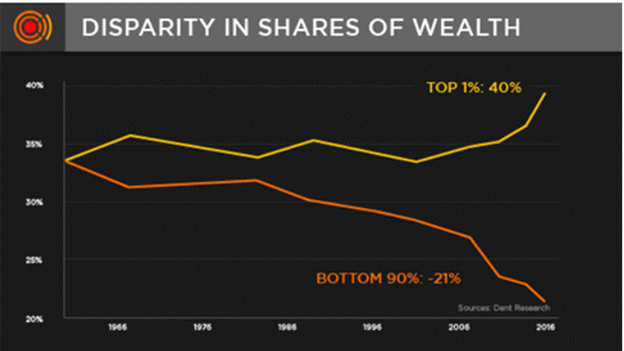
Now, by deliberately cranking rates higher, Powell’s Fed is making the middle class (bottom 90%) even poorer.
Wealth inequality in the US has NEVER been higher, and this never bodes well for the future of an openly fracturing nation.
Indeed, inflation pains and rising rates certainly hurt all Americans.
For the wealthy, such inflationary pains sting; however, for the working class, they cripple.
And as far as this crippling effect of “softening demand” goes, we can blame that squarely on the narrow shoulders of such false idols like Greenspan, Bernanke, Yellen and Powell.
For years, they’ve been saying their mandate was to control inflation and manage employment.
But that employment (as confirmed by PWC, household surveys and our own two eyes) is about to see hiring freezes, downsizing and lay-offs as debt-soaked enterprises with tanking earnings and confidence levels cut costs and jobs.
Again: That’s not “softening,” that’s crippling.
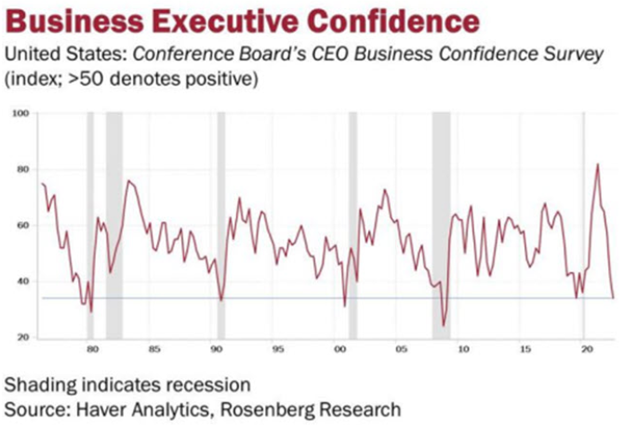
But as I’ve shown in Rigged to Fail and Gold Matters, the Fed’s real mandate is providing (now increasingly scarce) liquidity to credit markets (and hence tailwinds for the equity markets), which benefit a minority, not a majority, of the population.
This easily explains Andrew Jackson’s prescient warning that a central bank simply boils down to the “prostitution of our government for the benefit of the few at the expense of the many.”
Truer words were never spoken, and we are now seeing these warnings playing out in real time, and will see even more pain ahead in this surreal new normal of “softening demand” and a current America of central-bank created serfs and lords.
Powell’s words, of course, do not match his or the Fed’s deeds, a profile flaw that has been hiding in plain site since the Fed’s not-so-immaculate conception in 1913.
The more that investors understand where the decisions are made and why, and the more they track the market signals (bond yields, credit markets and currency debasements), the more they can prepare for what is already here and what lies ahead.
Powell’s Gettysburg Moment, the USD’s Waterloo & Today’s Open Madness
With the USD losing influence, it would be the understatement of the year to say that we live in interesting times, for we certainly do.
But despite the inevitable attacks of appearing sensational, un-American or just plain cynical, I feel a more appropriate phrase boils down to this:
“We live in dishonest times.”
Below, I bluntly address the “Fed pivot debate,” the “inflation debate” and the USD’s slow global decline in the setting of a now multi-FX new normal in which gold’s historical bull market has yet to even begin.
These views are not based on biased politics, but honest economics, which for some odd reason, ought to still matter.
Let’s dig in.
The New Normal: Open Dishonesty
I recently authored a report showcasing a string cite of empirically open lies which now pass for reality on everything from the CPI inflation scale to the Cleveland Fed’s +1 real interest rate myth, or from official unemployment data to the now comical (revised) definition of a recession.
But a more recent lie from on high comes directly from the highest of all, U.S. President Joe Biden.
Earlier this month, Biden waddled to his podium and prompt-read to the world that the US just saw 0% inflation for the month of July.
Oh dear…
It’s sad when our national leadership lacks basic economic, math or even ethical skills, but then again, and in all fairness to a President in open (and in fact sad) cognitive decline, Biden is by no means the first President, red or blue, to just plain fib for a living.
A History of Fibbing
We all remember Clinton’s promise that allowing China into the WTO would be good for working class Americans, despite millions of them seeing their jobs off-shored to Asia seconds thereafter.
And let us not forget that little war in Iraq and those invisible weapons of mass destruction.
Nor should we ignore both Bush and Obama’s (as well as Geithner’s, Bernanke’s and Paulson’s) assurance that a multi-billion-dollar bailout (quasi-nationalization) of the TBTF banks and years of printing inflationary money (Wall St. socialism) out of thin air was, “a sacrifice of free market principles” needed to “save the free market economy.”
In reality, however, we haven’t seen a single minute of free market price discovery since QE1.
Thus, Biden’s announcement that there was NO inflation for July is just another clear and optically (i.e., politically) clever lie among a long history of lies.
That is, he failed to clarify that although there may have been LESS inflation in July, this hardly means “no” inflation, as any American who has a bill to pay already knows.
Setting the Stage (Narrative) for a Fed Pivot
What the July CPI decline does achieve, however, is yet another headline myth to justify an inevitable Fed pivot to more easy money by year-end (i.e., mid-term elections) or early 2023.
As we see below, the fiction writers, data-gatherers and fork-tongued policy makers in DC have already been gathering more official “data” to justify a Fed pivot toward more dovish money printing and hence more currency debasement ahead.
In addition to a decelerating CPI report for July, DC has also been checking the following, pre-pivot boxes to allow the Fed to get back to doing what it was truly designed to do, which is print debased money out of thin air to save the US Treasury market rather than working class citizens.
Specifically, DC is pushing hard on the following “data points” and narrative:
- Decelerating inflation expectations
- Declining online pricing
- Declining PPI (Producer prices)
- Declining oil prices (from their highs)
So, has inflation peaked? Are the above declines proof that inflation creates deflation by crushing consumer strength and hence price demand? Is the Fed’s work nearly done in defeating inflation?
My short answer is no, and my longer answer is that when it comes to market, currency and economic conditions, there’s…
…More Pain Ahead
One clear sign that there’s more pain ahead, and hence more reasons for the Fed to pivot from temporary hawk to permanent dove, is the credit tightening now taking place in the US.
As I’ve said too many times to recall, the credit—and bond—market is the most important market and economic indicator of all.
Earlier this month, the Fed’s quarterly Loan Officer Survey came out with some scary and telling news, namely that the credit markets are tightening.
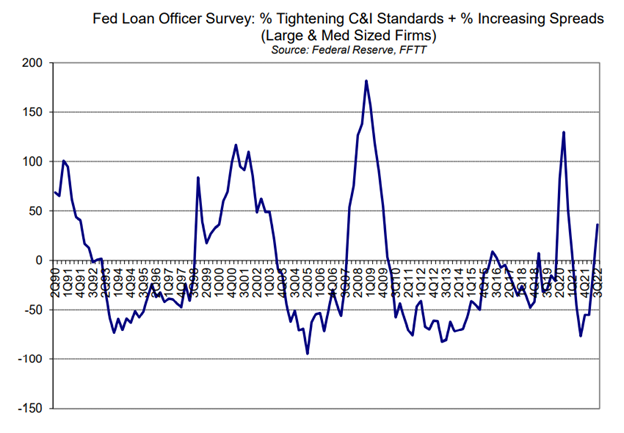
It’s important to know that in the last 30 years, a tightening of credit has always preceded a recession, even if DC wants to pretend that we are not in a recession.
The hawks may argue, of course, that during the inflationary 1970’s, tightening bank credit did NOT stop Volcker’s Fed from a hawkish rate hike policy.
But let me remind again that 2022 USA (with a 125% debt to GDP ratio) isn’t the Volcker era, which had a 30% ratio.
So, I’ll say it once more: The US can’t afford a sustained (Volcker-like) hawkish (rate-rising) policy–unless you believe the Fed is under direct orders from Davos to destroy America, which, I suppose is a fair belief, but one I’m not ready to embrace (yet)…
Despite Powell’s fear of becoming another Arthur F. Burns who let inflation run too hot, and despite his failed attempts throughout 2018, and again now, to be the tough-guy at the Fed, I still feel the Fed, for all the narrative points/reasons set forth above (including falling US tax receipts in July), is waiting for more weak economic data to justify a dovish pivot toward more QE rather than less inflation.
Why?
Because the Fed’s Only Job is to Keep Uncle Sam’s IOUs from Drowning
The only way to keep US Treasuries from tanking (and hence bond yields and interest rates from fatally spiking), is for the Fed to print more money to buy Uncle Sam’s otherwise unloved debt.
And this can only be done with more, not less, QE down the road.
Of course, money created with a mouse-click is inherently inflationary and inherently fatal to the purchasing power of the USD, which is why gold is inherently poised to out-perform every fiat currency in play today, including the world reserve currency.
But as for gold’s rise, in addition to the dis-inflationary recessionary forces (which require a weaker dollar and lower rates to fight), there’s a lot going on outside the US which further points to gold’s pending rise.
Little Trouble in Big China?
Investors may have noticed that money is fleeing China in droves. Capital outflows are reaching levels not seen since 2015, which sent the Yuan to the basement by 2016.
Does this mean the FX jocks should start shorting the heck out of the Chinese Yuan (CNY)?
I think not.
In fact, the CNY is holding its own despite massive capital outflows.
But how?
China: Openly Mocking the U.S. Dollar and the Back-Firing Putin Sanctions
The openly back-firing, financially-inept and politically-arrogant Western sanctions against Putin’s war amounted to the biggest game-changer in the global currency system since Nixon closed the gold window in 71.
More to the point, and despite massive capital outflows, the CNY is remaining strong because its FX reserves (i.e., its national savings account denominated in foreign assets) are actually rising not falling.
Huh? Why? Where’s the money coming from?
Answer: Just about everywhere except for the dollar-led West.
That is, nations like China and Russia, who have been chomping at the bit for the last decade to de-dollarize, are now doing precisely that in the wake of recent moves by the West to weaponize the USD by freezing Russia’s FX reserves.
Myopic sanction chest-puffing by the West has given the East the perfect pretext to fight back financially and monetarily, and they are fighting to win a heating currency war.
No Dollars, Thank You
Specifically, countries wishing to purchase Chinese imports (i.e., commodities) now have to pre-convert and/or settle those purchases from local currencies into CNY rather than the once SWIFT-and-world-dominated USD.
In short, the USD is no longer the toughest guy in the room nor prettiest girl at the dance.
This is becoming more evident as headlines confirm Indian companies swapping USDs for Asian currencies, China and Saudi Arabia concluding energy deals outside the slowly dying (and forewarned) petrodollar, and the Russian Central Bank considering buying the currencies of friendly nations like Turkey, India and China.
As commodities like oil (priced-up 30% since 2018) leave places like China and Russia, they can now be purchased with local national currencies (Indian, Brazilian, Turkish) which are then converted into CNY.
This procedure adds massively to China’s FX reserves (especially when oil prices have been rising), thereby allowing its currency to stay strong despite massive capital outflows.
From Mono-Currency to Multi-Currency
In short, and despite Western attempts to flex its currency muscle via USD-driven sanctions, nations like Russia and China are now leading the charge from a one-currency world to a multi-currency world of import payments.
With its FX reserves frozen by the West, Russia, for example, can take its energy profits and Rubbles to purchase the currencies of friendly countries like China, India and Turkey to rebuild its reserves outside of the USD.
In this manner, and as I’ve repeatedly warned (in articles and interviews) since February of 2022, the West has shot itself and the world reserve currency in the foot.
The old world is slowly but surely turning irreversibly away from a USD-dominated currency system toward a multi-currency and multi-FX pricing model.
And as we head into winter, nations like the UK, Japan, Austria and Germany, who blindly towed the US line, will be feeling the cold pinch of backing the wrong policy as other nations stay warm/heated with oil and gas that can be bought outside of the old, USD-led system.
As energy prices continue to cripple the West, especially here in the EU, will such nations like the UK, Austria or Germany bend or stay firm?
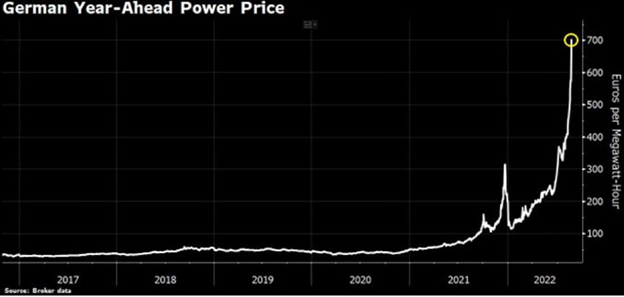
Either way, the USD is the open loser over time, and will never be trusted as neutral currency again.
But agree or disagree, you may still be asking: What does any of this have to do with gold?
It Has Everything to do with Gold
As more nations turn away from the West (and the USD) and closer to the East (i.e., Russia) to meet their energy needs, how will they find the Rubles or Yuan to buy their oil, gas and other commodities?
After all, in the new, post-sanction, multi-FX importing model described above, Turkey can’t just buy Russian oil in Lira; it needs to first settle the trade in Rubles.
So, again, what currency will Turkey use?
From Petro-Dollar to Petro-Gold
John Brimelow, a consistently brilliant gold analyst, has given us a pretty obvious hint/answer: YTD Turkish gold imports are up 44% to nearly 70 tonnes, and can easily reach prior levels of 300 tonnes per annum.
In other words, Turkey could be dumping US dollars to buy gold at what we all know is a deliberately rigged (i.e., low) COMEX/LBMA price.
Turkey can then sell that gold to Russia’s central bank in exchange for Rubles “at a negotiated price” otherwise needed to purchase Putin’s oil.
Given that the physical oil market is nearly 15X the physical gold market, one can only imagine what further oil-for-gold transactions as per above will do for the rising price of a scarce asset like gold.
See the Sea of Change?
See how the USD is slowly losing its shine?
See why gold is slowly gaining in shine?
See how the US-led sanctions were the biggest political and financial policy gaffe since Kamala Harris tried to locate the Ukraine on a map?
See why the BIS/COMEX/OTC price fixing of gold earlier this year was the perfect (and artificial, legalized fraud) timing needed to keep gold cheap for other nations to buy?
Rhetorical Questions
Perhaps all this interest in gold rather than the USD explains Saudi Arabia’s recent push to refine gold within its own borders?
Perhaps this also explains why less-favored nations to the US (i.e., Nigeria and India) are launching a bullion exchange and opening gold trading?
Perhaps gold’s new roles are why the BIS, the biggest player (legalized scammer) in the paper price fixing of gold, has unwound nearly 90% of its gold swaps over the course of a year (from 502 to 56 tonnes)?
And perhaps gold’s stubborn significance further explains why the two biggest US gold price manipulators in the futures pits, JP Morgan and Citi, have been grotesquely expanding their gold derivative book (they own 90% of all US derivative bank gold) at the same time the BIS was unwinding their swaps?
Why?
Simple: To keep a boot to the neck of the natural gold price just a bit longer as they accumulate more of the same before the very currency system they helped ruin finally implodes?
Honest not Sensational: Gold’s Bull Market Has Yet to Even Begin
Given the dishonest times in which we live, and given all the mechanizations sited above, it would not be sensational to remind conventional investors what most gold investors already know: Gold is most honest and loyal when dishonest and disloyal markets implode.
Hedge fund managers and other candid analysts are collectively and already foreseeing massive market pain ahead, as Egon and I have been warning for years.
The big boys are now net-short US Equity futures:

Whether re-valued by oil, or simply re-valued by fiat currencies which have increasingly no value, gold can easily reach levels which current investors can’t imagine.
After Nixon’s debacle in 1971, gold surged 400% in just one year between 1973-74.
Watch the Foxes, not the Hen House
The TBTF banks have no morality in my mind. I’ve written of their open fraud for years.
Ever since folks like Larry Summers repealed Glass Steagall and turned banks into casinos and bankers into speculators (with depositor money), nothing the big banks do is either fair or fiduciary.
Ironically, however, it is fair to say that even these banks will be hoarding more physical gold (at currently repressed/rigged prices) as the world they created implodes under its own systemic sins.
And if JP Morgan or Citi is getting prepared, shouldn’t you?
After all, better a fox than a hen, no?
Powell’s Gettysburg Moment, the USD’s Waterloo & Today’s Open Madness
Once again, the US is facing a recession which Main Street feels, Wall Street whistles past, and DC simply denies.
Below, we look at these recessionary forces and delusional policy makers in the context of blunt-speak rather than Fed-speak so that we can best prepare for what’s already felt but rarely spoken from on high.
De-Coding the Latest Fed-Speak: Hawks, Doves or Both?
As expected, and as already priced-in by the markets, the Fed raised the Fed Funds Rate (FFR) last week by 75 bps in what superficially appeared to be a hawkish assault on inflation but what in reality was nothing more than another monetary bluff.
Alas, there’s far more hidden dove than public hawk emanating from Wednesday’s latest Fed “guidance.”
As I’ve consistently argued, the Fed has wanted to exploit (rather than defeat) inflation as a classic means of secretly “inflating away” chunks of its embarrassing debt pile while publicly pretending to “combat” inflation with anemic (6.75% y/y) rate hikes (and a 2.50% FFR) which will never catch up with (and therefore never defeat) current inflation rates above the 9% level.
Everyone, including Powell, knows that Uncle Sam can’t afford rising rates or a perpetually strong USD.
So why the public ruse to “fight” 9% inflation” with 2.5% FFR?
Simple: The Fed sees a recession coming and needs to raise rates today so they’ll have something—anything—to cut tomorrow.
Dovish Pivot Translated
Thus, and as consistently argued, the Fed’s hawkish July chest-puffing will eventually (i.e., when the recession becomes official) lead to some dovish two-stepping as Powell has effectively telegraphed a future rate hike pause by using the magic words “depending on the data.”
In short, I believe the Fed is looking for an excuse to print more dollars and cap more yields/rates with more inflationary mouse-click magic money and hence more Main Street pain—all very bad for a debased yet relatively strong USD and all very good for real monetary metals like gold.
Stated simply, I feel last Wednesday was the first sign/hint of an inevitable Fed pivot from rising rates to pausing rates, and then eventually, falling (YCC) rates and a falling dollar over the coming months and quarters.
We’ll know more at the end of August when Powell scoots off to Jackson Hole as the rest of the US sinks deeper into a recessionary hole.
Recession Translated
And what’s the new excuse for the inevitable pivot to more artificial “accommodation” (i.e., QE) rather than the current and fake “inflation fighting” QT?
Powell described it in Fed-speak as “watching for a slowdown in economic activity.”
Translated into honest-speak, this just means that Powell’s narrative will be shifting from inflation semantics to recession realities, despite every current effort made from DC to deny a recession.
I’m always impressed by the Fed’s ability to pervert English, math and honesty in the name of fantasy, calm and policy.
As we’ve shown elsewhere with blunt math rather than sensational drama, the Fed, and its minions at the BLS, have literally invented a magical calculator which makes 2+2=1 on everything from CPI Inflation, and the M3 Money Supplyto the current metrics used to turn privately sought negative real rates into publicly positive real rates.
With so much dishonesty from (and hence distrust of) the policy makers, it thus comes as no surprise that even the definition of a recession is now being perverted to supplant reality with fantasy and thus keep the masses comfortably numb from the consequences of the Fed’s increasingly failed monetary policies—namely a Fed-engineered recession to deflate Fed-made inflation.
But can any of us remember the last time a central banker stood up and confessed: “Boy, we really screwed that up, got that wrong, and are now facing years of self-inflicted misery; sorry about that”?
Or can any of us imagine a central banker saying: “OK, we’ve been lying to you for years about true inflation levels, which we actually need to pay down the debts we’ve helped create and which we will now use a recession to quell. Sorry about that.”
A Lesson in Recessionary Realism
Luckily, we’re not interested in the Faustian bargain required to work in DC, so we can all enjoy some honest math and cold data when it comes to confessing recessions.
As most already know, two consecutive quarters of declining real GDP is how recessions are defined and have been defined for years.
Powell, Yellen and Biden’s press secretary, however, will nevertheless assert that the real definition of a recession is suddenly not as simple as that.
Hmmm.
Ok. So how about if we add the following facts (and leading indicators) to help our financial leadership in DC confess that a recession is precisely where we are headed and frankly already standing.
Toward this end, let’s share a few data points they might have overlooked when backpedaling on the “recession” question, namely
1. U.S. New Home Inventories are at the highest levels since 2018 and pending homes sales (reeling under the weight of rising mortgage rates) fell y/y by 20% in June.
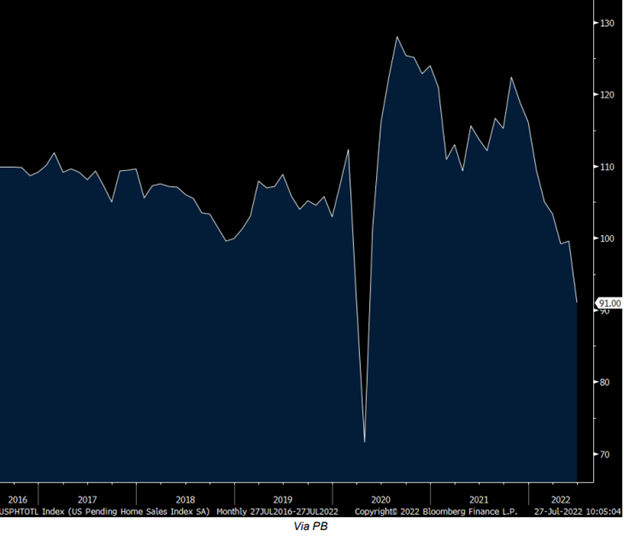
2. Housing data is directly linked to tax receipt data. That is, both fall together, and as tax receipt income falls, this too is a recessionary indicator, as falling US tax receipts are equally correlated to falling US stock prices.
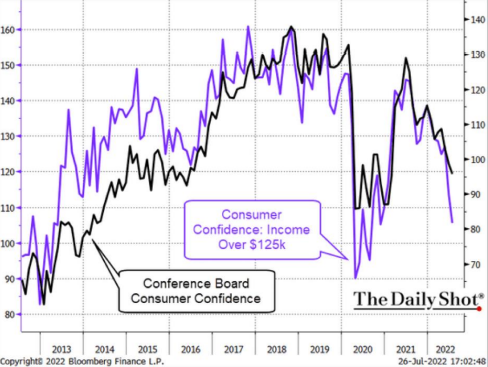
3. Advertising budgets/spending policies are falling at places like Amazon, while inventories at places like Walmart are rising as their profits are falling, including names like Target whose stock price tanked by 24% on Q1 earnings misfires; and…
4. Hawkish rate hikes and a strengthening USD are a poison to the earnings flows of such enterprises already in debt up to their ears after years of “free debt” expansion in the backdrop of repressed rates and post-08 unlimited money printing.
By the way, such ad-spend cuts, falling earnings, tanking profits, and new-hire slowdowns seen across the US at retailers like Walmart, Target and Amazon are typical and leading recessionary indicators which often precede/portend future labor layoffs.
5. Consumer confidence among even the higher-income US population is sinking fast:
6. Rising rates and the strong USD policy pursued by Yellen and Powell has made the cost of US entitlements (i.e., health, social security etc.) painfully worse and ultimately unsustainable.
When Yellen was drunk-driving at the Fed, for example, those entitlements were 54% of US tax receipts in 2015; today, as spending increases and inflationary 10% “cost of living adjustments” (COLA) are honestly applied, annual US entitlement payments will very soon reach 90% of US tax receipts.
In short, the current and “hawkish” rising-rate-strong-USD policy at the Eccles building will bankrupt the federal government unless a pivot is made soon to fill the spending gaps and deficits with more fake fiat money—i.e., more QE.
After all, that needed money is certainly not coming from an anemic GDP, a topping and tanking market and hence declining tax receipts.
7. As to Uncle Sam’s embarrassing bar tab, he is facing $23T of outstanding IOU’s, 30% of which are poised to re-price at the end of this year at a higher (6.75%) rather than lower annual rate, which boils down to roughly $460B in additional spending (12% of tax receipts) just to cover those rising interest expenses.
Thus, unless the Fed hits the “QE-Button” very soon, Uncle Sam will be hiding from his creditors behind the Fed and its currently dim “happy hour” sign.
8. At the global level, nearly every major “developed economy” is little more than a glorified banana republicmathematically staring down the barrel of a sovereign debt crisis as governmental rates (i.e., the cost of borrowing) are rising at the very same time that economic growth and new export orders are sinking:
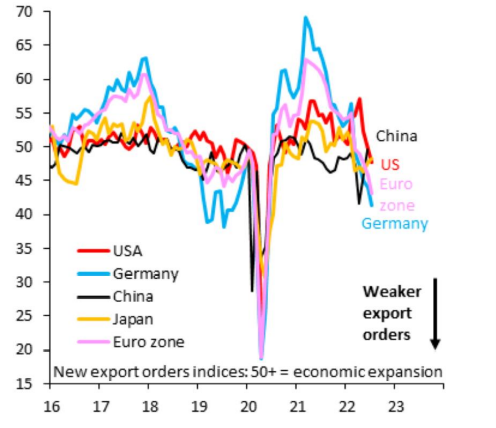
Meanwhile the Pravda-Like Denial Continues
Despite each of the foregoing hard facts, US Treasury Secretary, Janet Yellen, is leading the official DC chorus in a now openly pathetic effort to deny reality in ways reminiscent of the Soviet era circa 1963.
According to Yellen, and after back-to-back quarters of negative GDP growth, “there’s no evidence of a recession now.”
Such words once again confirm how central bankers are nothing more than word-smith politicians (propagandists?) dressed in banker clothing and broken (free-market) high heels.
Math and hard data are no longer the key focus of our central bankers. Like candor and ethics, they’ve replaced sincere numbers with political nouns and false narratives.
It seems today that along with science, culture, comedy, creativity and history, the very discipline of economics has itself been canceled.
What to Expect?
In such a distorted, desperate and frankly dishonest backdrop of form over substance and false narratives over honest math, what can the rest of us expect from our central planners on high and our real world experience on the ground?
As I recently argued, the Fed knows it will not beat inflation (which it secretly needs) via rising rates.
Instead, Powell will centrally engineer a currently “deniable” recession (which is dis-inflationary) to publicly “combat” otherwise deliberately sought inflation.
Toward this end, these fork-tongued bankers will also pull out their usual tricks and magical calculators to convince the world and markets that officially reported inflation levels are honest (despite being at least 50% under-reported) while simultaneously and deliberately pursuing a policy of negative real rates (i.e., inflation rates above interest rates) as they publicly and dishonesty report them as positive.
So yes, a recession is here, and a longer and deeper one is coming.
The Fed will use words and dishonest math to calm the cognitively dissonant from an abrupt market sell-off or a collective wising up.
As I see it, the Fed can postulate and chest puff a hawkish and rising rate policy for now and perhaps even into the fall.
But unless the Fed in particular, and the major central banks in general, wish to “defeat” inflation by catapulting the world into a global recession whose depth, duration and pain will be extreme, they will have no mathematical nor even political choice but to lower rates, weaken their currencies and fight recessions within their front yards.
As recently argued, no nation, regime nor system in history has conquered a recession by jacking up rates and strengthening their currency.
Given the evidence above, the US is heading straight into a recession and as such will be forced to confront that reality (however downplayed or officially postponed) by cranking out the mouse-click money in a way which will cap yields, debase the dollar and thus be a tailwind for precious metals across the board.
Unless, of course, you think all that data above is fake news and that the Fed has outlawed recessions, in which case all is fine and will always be fine, right?
Powell’s Gettysburg Moment, the USD’s Waterloo & Today’s Open Madness
Many are asking about Gold’s rise, or better yet: When, how and why it will rise?
Toward this end, cold data in the face of historical facts and current recessionary realities will make gold’s rise easier to grasp.
Let’s start with the cold data, which centers around officially reported real rates and relative USD dollar strength, two current and key headwinds to gold’s rise.
Cold Data Point 1: Real Rates
As we’ve written previously, there is a clear inverse relationship (95% correlation) to real (inflation-adjusted) rates and the gold price.
Stated simply, when inflation outpaces the yield on the 10 UST, the net result is a negative real rate environment. Conversely, when rates (as defined by the yield on the 10Y UST) are above inflation, we have positive real rates.
Gold, as a real asset that produces no yields or dividends, shines brightest when real yields/rates are negative.
After all, when bonds produce negative returns, investors look more favorably toward real assets like precious metals.
Today, one would think that soaring Year-over-Year (YoY) inflation in the U.S. at 9.1% (and closer to 18% using the more honest 1980’s CPI scale) against a 2.89% nominal yield on the 10Y UST would seem to be a screaming indicator of negative real rates and thus a profound tailwind for gold, right?
And as to inflation, we said over a year it ago it would skyrocket while Powell promised it was “transitory.”
After all, when a nation expands its money supply by 40% in a two-year period prior to COVID and Putin, one can’t just blame inflation (or a later Fed Balance Sheet expansion from $4.2T to $8.7T) on a virus or Russian bully.
Based on these cold facts and the subsequent (and monthly YoY) CPI figures, who was more candid (and accurate) about transitory inflation? See a trend?
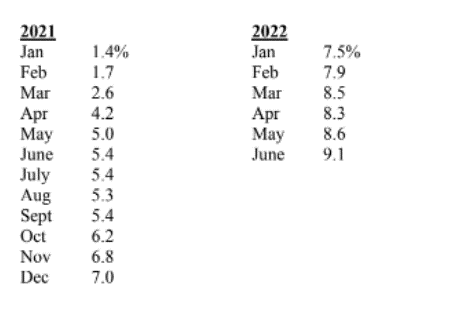
Getting back to real rates, a 2.9% nominal yield minus the above 9.1% inflation rate = negative 6.21% real yields.
Easy-peasy and good for gold’s rise, right?
Well, nothing is that simple in our new central bank normal…
Fudged Math
Whether you believe in central banks or “official” inflation data (and we certainly do not), this doesn’t change the equally cold fact that central banks (or central controllers) are nevertheless always right, even when they are empirically wrong.
According to the Fed, for example, the Real Rate on the US 10Y UST is +1.06%.
See for yourself.
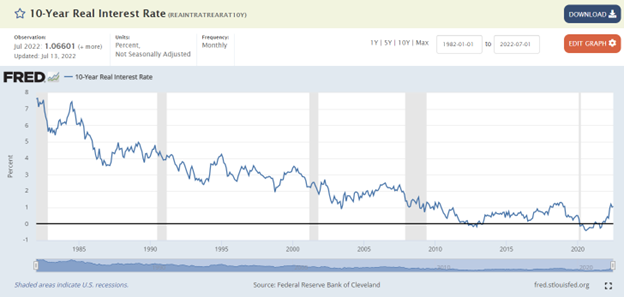
Huh?
How does a negative 6% become a positive 1%?
Short answer: Clever Fed math (mixed with deflationary expectations priced into the duration of the bond).
Huh?
As indicated in many prior reports, the Fed, much like Al Capone’s accountants, are masters at manipulating, downplaying, obfuscating or just flat-out non-reporting embarrassing facts, including severe inflation realities, to create fictional calm.
Thus, when publicly charting otherwise embarrassing real rate data, they employ a spiders-web of clever math and proprietary models to come up with a downplayed inflation rate against which they measure nominal rates to derive a fictional “inflation-adjusted” real rate.
In other words, they fudge the numbers.
In the example above, rather than using the otherwise simple 9.1% YoY inflation rate, the Federal Reserve Bank of Cleveland offers us an official mash of “expectations”, “risk premiums,” “real risk premiums,” the “real interest rate,” as well as a “model” that mixes “data, inflation swaps” and even “surveys” just to avoid stating what is already abundantly clear: Real rates today are -6.21 not +1.06.
In essence, the foregoing Fed math hides the blunt reality of current inflation by saying they foresee deflation ahead over the duration of the 10Y UST.
And as we discuss below, they may ironically be correct but for all the wrong reasons…
For now, and given the “official facts” as presented by the never-wrong Fed, current real rates on the 10Y UST are often mis-presented as slightly positive rather than honestly reported as deeply negative.
And as stated above, this fiction has been a clear, deliberate (and temporary) headwind for gold’s rise.
Cold Data Point No 2: Rising (but Short-Lived) U.S. Dollar Strength
The USD, of course, has been rising at astronomical levels (7% in Q2), and this too is often a headwind to gold’s rise, as a rising dollar appears/appeals to many investors (foreign and domestic) as a safer haven than precious metals.
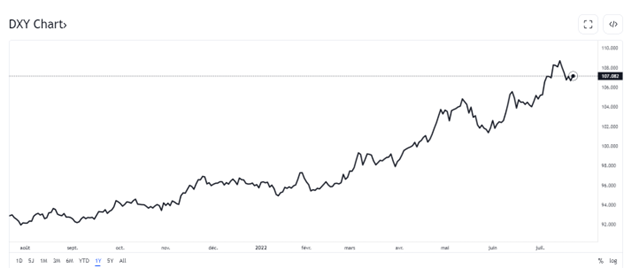
In fact, a rising USD and rising rate environment was immediately (and predictably) bad for just about every asset class, though far less so for gold’s rise. There were few places to hide.
Percentage declines across asset classes for 1H 2022 proved this point:
NASDAQ 100 Down 29.3%
S&P 500 Down 20.0%
Emerging Markets Down 17.2%
US Govt Bonds (TLT) Down 21.9%
Real Estate (XLRE) Down 20.1%
HY Bonds (HYG) Down 13.8%
Muni Bonds (MUB) Down 7.8%
Gold Bullion Down 1.2%
We’ve explained this dollar rise in prior reports as a desperate yet explicable attempt by Yellen and Powell (and Biden and Summers) to attract foreign inflows into U.S. markets wherein the USD is seen as a relatively superior “safe haven” when compared against other global currencies, like the Euro, whose debt levels (and non-reserve currency status) can’t endure equally hawkish rate hikes.
That is, by pursuing deliberate and well-telegraphed rate hikes (50 bps in May, 75 bps in June and potentially more to come in July), the Fed, for now, has made the USD the best currency horse in the international fiat glue factory.
This deliberate policy to make the USD stronger is a temporary tool to “fight” inflation, as it reduces the cost of import prices within the U.S.
A German toaster, after all, costs less when the USD reaches parity with the Euro.
But a stronger USD also strangles U.S. export competitivity and adds to increased U.S. trade deficits longer term, which is one (but not the main) reason the strong USD policy will be short-lived (see below).
Why short-lived?
Because as indicated above, historical facts and current realities all converge toward a recessionary landscape in which weaker currencies and lower rates are the only path forward.
What makes us think so?
The Historical Facts and Cold Math of Recessions
Despite the post-2008 Fed’s valiant yet vain (really vain) attempts to convince the world that recessions have been made extinct by mouse-click monetary policies, the simple yet common-sense reality is that recessions have not been outlawed (but merely postponed) by such fantasy fiat dollars.
Deep down, we all know this, even the market bulls: You can’t solve a debt crisis with more debt paid for with money created by a computer rather than GDP.
The other simple yet common-sense and historical reality is that no recession (not one, not ever) can be defeated in a backdrop of high rates and a strong currency, the very policies which the US is currently and temporarily pursuing.
Despite the fatal hubris and immense power of the Fed, the U.S. will be no exception to these recessionary realities and consequent policy shifts.
The markets (from the NASDAQ to Muni-bonds) can’t afford rising rates and will continue to fall as Powell pretends to be a rate-hiking Volcker despite forgetting that Volcker was facing a 30% debt to GDP in 1980, not 125% ratios in 2022.
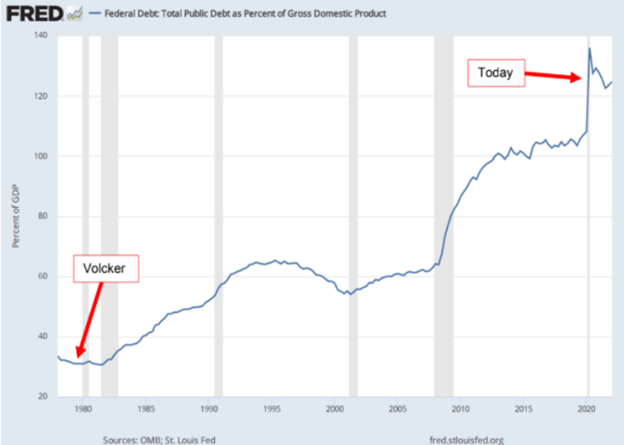
Powell may want to believe he’s a Volcker, and I’d like to ride a horse like Adolfo Cambiaso or throw a fast ball like Nolan Ryan, but it ain’t gonna happen.
In short: Powell will pivot as the grotesquely over-heated bubble markets the Fed created start tanking further.
Tech stocks (of which we consider BTC to be) are uniquely poised for further pain…
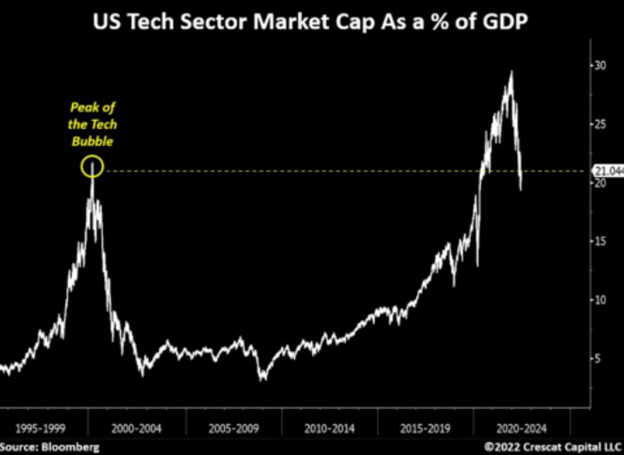
Like the Q1-Q4 2018 rate-hikes to the predictable 2018 Q4 market beat-down (and hence 2019 pivot), the Fed will reduce rates and the USD will weaken in a QT to QE pivot once the recession off (or already under) our bow slams into our debt-soaked and sinking Titanic economy and markets.
Current Realities: Recession Ahead (or Already Here?)
Recessions become official (and lagging) once the number-crunchers (i.e., fiction writers) in DC officially tell us so, namely, once they report 2 consecutive quarters of negative GDP (i.e., too late for most retail investors who still trust the Fed).
Thankfully, there’s no need to hold our breath. Despite already feeling like we are in a recession, the Atlanta Fed GDPNow data has confirmed a negative Q1 GDP (-1.5) and foreshadowed a 0 to negative Q2 GDP.

In short, we are likely already in recession, and this neither bothers nor surprises the Fed. After all, the same bankers who built the inflationary bubble will trigger the deflationary recession to follow.
Stated more simply, and when it comes to market bubbles, the Fed giveth and the Fed taketh away.
The Fed’s Real Anti-Inflation Weapon: A Deflationary Recession
Despite pretending to fight inflation with rising rates, the Fed knows its nervous rate hikes (be they at 50, 75 or even a 100 bps) won’t defeat current inflation, which is considerably much higher than officially reported. Negative rather than positive real rates are already (albeit unofficially) in play to deliberately “inflate away” some of Uncle Sam’s embarrassing debt.
By lying about (i.e., “fudging”) the inflation data, the Fed therefore gets to have its cake and eat it too; namely it can privately exploit extreme inflation while publicly pretending/reporting it lower than it actually is, even at these embarrassing levels.
(Of course, another way to calm inflation fears is to intentionally repress the paper price of gold on the COMEX, of which we’ve written extensively.)
Yet looking ahead, the historically most accurate tool for fighting inflation (and crushing Main Street), of course, is a recession, wherein economic growth and consumer demand weakens and hence prices (and inflation) fall—i.e., deflationary forces.
The Fed knows this too. Nothing fights a Fed-created inflation like a Fed-induced recession. Thanks Mr. Powell.
The current chest-puffing claims by the Fed to send the Fed Funds Rate to a “projected” 3.8% by 2023 is, in my opinion, just another Fed ruse, as nearly all its “projections” have been in the past.
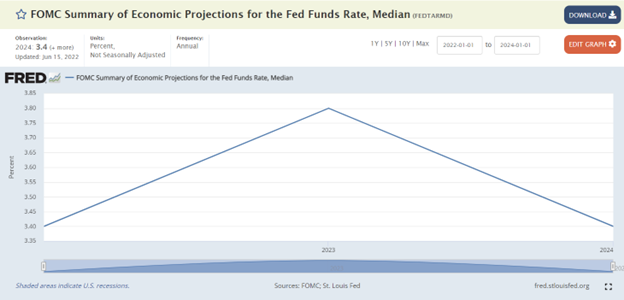
At $30T+ in public debt, Uncle Sam (or Mr. Market) can’t afford such “projections.”
For every 1% rise in rates, the cost of servicing Uncle Sam’s $30T+ bar tab rises by $27 million per day.
And WHEN not IF the recession hits the U.S., the Fed knows all too well that there is no way out of that dis-inflationary (and long-term) recession other than lower rates and a weaker USD—all good for gold’s rise.
As our advisory colleague, Ronni Stöferle recently observed: “The current cycle of interest rate hikes could go down in history as the shortest and weakest in recent decades.”
Why?
Because, 1) economic activity and growth is slowing (and has been for years), 2) indebted nations can’t afford meaningfully higher rate hikes, 3) inflationary debt relief is counter-acted by increased government spending, and 4) markets are already pricing-in inevitable rate cuts.
The Return of the Money Printers—Just a Recession Away
And what’s the best method to 1) cap or cut rates (as Japan’s current YCC confirms), 2) weaken the currency and 3) spur “growth” in a recession?
Easy: A money printer to artificially suppress bond yields and weaken (debase) the currency.
Again, this means the inevitable pivot from current hawkish tightening to future dovish easing is just a recession away.
For now, and as stated elsewhere, the Fed’s (and Canada’s) hawkish rate hikes today have been engineered not to fight inflation, but simply to have room to cut rates tomorrow when the recession our central banks have been postponing with mouse-click dollars comes painfully home to roost.
Gold Price Reaction, Gold’s Rise
This inevitable shift from a rising dollar and rising rate setting to a falling dollar and repressed (but still negative) rate reality in a recession will be an extreme catalyst for gold’s rise, now currently and intentionally suppressed by: 1) an openly rigged COMX market, 2) a disingenuous “anti-inflationary” rate hike policy and 3) a short-term strong dollar policy to fight mis-reported (i.e., much higher) inflation.
My colleague, Egon von Greyerz, would remind that gold’s rise is based on more than just inflation and deflation fluctuations or rising or falling rates.
Indeed, gold’s rise in the past has occurred in environments of a strong dollar, a weak dollar, a rising rate and a falling rate.
There are many specific reasons and contexts for this, too numerable and nuanced to unpack in an article, which is why we’ve authored a book (Gold Matters) to explain the same in greater detail.
There’s More to Gold’s Rise than a USD
Furthermore, and as anyone owning gold in currencies other than the USD already knows, gold’s rise has been considerably stronger against currencies who don’t have the bullying power of the USD—namely the power to export inflation or pivot from Hawk to Dove to Hawk because of a world reserve currency status.
The EU and its central bank, for example, are so thoroughly debt-strapped and dependent upon USD-based markets, debts and settlement policies that even an ECB rate hike move from 25 bps to 50 bps has LaGarde shaking in her designer boots.
France, from where I sit, has a total debt to GDP ratio of over 350% and Italy, whose debt and political coalition confusions are no mystery to European citizens, is an early warning sign of future economic and political fracturing in the EU.
Germany, meanwhile, will soon (2023) have to pay the bill for the inflation-adjusted bonds it issued in prior years, the cost of which will be 25% of the nation’s total debt.
And as for Japan and its dying Yen (at 50-year lows and down 24% in dollar terms in the first half of 2022 after decades of mouse-click money madness/QE), this nation is effectively a financial zombie.
Again, these are just cold facts.
Not Even the USD Can Avoid Nature
Despite the slow, very slow process of de-dollarization set in motion by openly failed/backfiring sanctions against an energy-rich Putin, the USD remains uniquely positioned (via its petrodollar, its SWIFT pre-eminence and its post-war reserve currency status) to sin deeper and longer with its centralized money printers, fictional CPI authors and disingenuous rate policies.
But not even the USD and an artificially engineered and controlled market economy can escape the inevitable and natural consequences of over-expansion, over-dilution/debasement and over-indebtedness.
Regardless of how the Fed and other central banks misreport inflation, recessionary realities will make the genuine nature and future of negative real rates a reported reality, which will create an optimal setting for gold’s rise.
As I, Ronni Stöferle and many others have argued for well over a year, the developed economies (which are in fact little more than debt-soaked banana republics on paper) cannot endure (ertragen) the reality of an international debt crisis which would surely follow any prolonged policy of rate hikes into a global debt swamp of over $300T.
Gold owners will benefit most from these inevitable changes and realities, as all currencies and all central banks are running out of tools, options and excuses.
As in hockey, polo or asset prices, the best players look to where the puck or ball is headed, not where it currently sits.
The forces discussed above (recessionary, rate and currency) collectively, historically, empirically and common-sensically point toward new highs for gold, whose bull market, which began to stretch its legs after the 2016 bottom of $1050, has yet to sprint ahead.
But gold will sprint fast and higher north, even if it does not feel like it today.
Powell’s Gettysburg Moment, the USD’s Waterloo & Today’s Open Madness
As repeated in numerous articles and interviews, global central banks in general, and the Fed’s Jerome Powell in particular, have placed themselves and the global markets and economy in a trap from which there is no escape short of biting off their own feet, as they’ve had a foot in their mouths for years.
Or as Mohamed El-Erian said best: “The Fed has no good scenarios left.”
This blunt point simply can’t be repeated enough.
Candor (and Debt) Matters
With global debt at $300T+, and combined U.S. corporate, household and public debt well past $90T, the Fed’s “face-saving” attempt to raise rates (even to the unsustainable level of say 4%-5%) as a weapon against 9% reported (i.e., under-rated) CPI inflation is a failed strategy from the start.
In fact, it is delusional at best, and more likely dishonest at worst. Full stop.
Simply stated, an historically debt-soaked market, economy and government addicted to years of artificially repressed free money can’t suddenly afford a meaningful rate hike (i.e., expensive money) without a fatal string of credit defaults, from investment grade to sovereign bonds.
Facts Portend the Future
Toward this end, we’ve dedicated years to fact checking, BS-detecting and calmly disclosing a long string of open rigging, lies and errors masquerading as policy which have poured from the lips and policies of figures like Greenspan, Bernanke, Yellen and Powell.
Despite the stubborn honesty of such facts and dishonesty of our bankers, many FOMO investors have clung to the cognitive dissonance of believing central banks had their backs—and their markets and currencies in eternally safe hands.
Now, as the transitory inflation lie has broken the credibility of these lost shepherds and the faith of their sheep, the financial word is facing the first chapters of a global “uh-oh moment” (i.e., geopolitical risk, falling markets, debased currencies, failing leadership, and increasing social unrest), the inevitability of which we’ve warned in two published books and countless reports.
Most reading this, of course, are not among the sheep nor the surprised. Yet even for you and us, the continued hubris, ignorance and dishonest desperation of our so-financial “leadership” never fails to astonish.
Let’s see why.
Apparently, Powell is afraid of going down in history as the next Arthur Burns.
Not surprisingly, he appears more pathologically concerned about his personal legacy than the fatal legacy he and his predecessors have left the inflation sick nation after inflating the Fed balance sheet from $800B pre-08 to over $9T today.
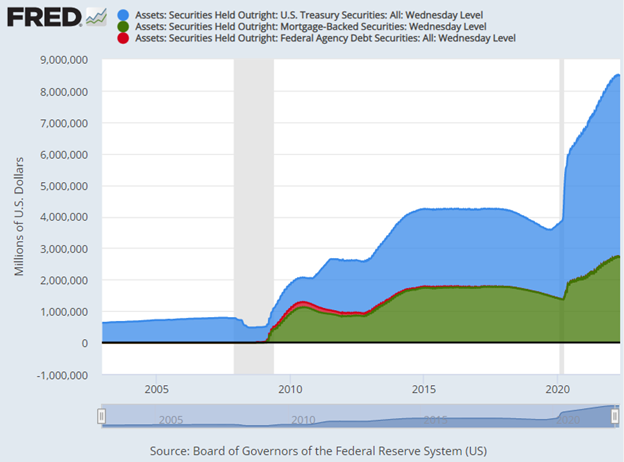
Despite the obvious and direct inflationary consequences of such balance-sheet expansion, everyone in a DC office (from Biden to Powell) wants to save their reputational behinds and blame the consequences of decades of their openly inflationary monetary policies on a virus and a bad guy in Russia.
How’s that for profiles in courage?
And even now, Powell still thinks he can emerge as the next Paul Volcker by raising rates to fight the inflation he helped create.
Man, the ironies do abound.
Folks, Powell is no Volcker.
A Lesson for Mr. Powell: Debt Matters
Mr. Powell, if you are reading this, let us remind you that when Paul Volcker was raising rates, the US public debt was below $900B, not the current $30 TRILLION debt level which the Greenspan generation (i.e., that includes YOU) directly created.
Let us also remind you that the “Volcker era” U.S. debt-to-GDP ratio between 1979 and 1981 was 31% and our deficit-to-GDP level was only 2%.
TODAY, our debt-to-GDP ratio is over 125% and our deficit ratio is approaching 7%.
Math, facts and debt are stubborn things, no?
This, Mr. Powell, explains why Volcker was able to raise the Fed Funds Rate (FFR) by over 1000 basis points to fight inflation, and this is further why even a pathetic 300 basis point rate hike under your watch by 2024 will be as ineffective to fight inflation as a submarine with screen doors.
By the way Mr. Powell, even a meek 3% FFR as you so “hawkishly” propose would leave our FFR rate lower than it has been for 98% of the last 67 years.
In short, if you are honestly pretending to fight inflation with a wimpy little rate hike like this (because 300 bps is about all that the gasoline-debt-soaked USA can afford thanks to you, Yellen, Bernanke and Greenspan making us debt broke), you are effectively bringing a knife to a gun fight (i.e., you’re gonna lose).
Furthermore, your proposed rate hikes (far too little, far too late) will raise the cost of Uncle Sam’s embarrassing bar tablevel from 7% to over 11% of our ever-dwindling GDP.
In short, Mr. Powell, you’re dreams of Volcker glory, or even Volcker efficacy, are only that: Dreams.
Dreams to Nightmare
For the rest of us, however, the nightmare you’ve unleashed and the “solution” you’re proposing is rigged (doomed) to fail.
Your FFR rate hike will create debt pains that will last for years, as the government’s average debt maturity is greater than 4 years.
Even these meager yet higher rates will (and already have) disrupted financial markets, strangled GDP growth, augmented welfare spending and shrunk U.S. tax receipts by 16% YoY in May and likely by 30% in June.
Ouch.
Mr. Powell, while crunching numbers in school, did you ever bother to read Hume or von Mises?
They would have shown you (with numbers not hard words) that GDP growth is mathematically impossibleonce debt levels are greater than 100%.
Or just ask Kuroda, as you can no longer ask Abe.
Although you will never be the next Volcker, you may want to purchase a biography of Benjamin Strong, the first Fed Chair to trigger a depression by not allowing inflation to run hot as mandated by the rules then in place (i.e., when the USD was tied to gold) …
Powell’s Real Plan? Let Inflation Rip
But then again, Strong’s mistake of not allowing inflation to run hot enough to “inflate away” U.S. debt may not be your mistake, but deep down your real plan?
In short, I’m guessing that more rather than less inflation is your only real option and plan, despite headlines (and rate hikes) to the contrary.
I’m guessing you’re only raising rates now so that you’ll have something, anything at all, to cut when markets truly tank, and we both know they will tank much further, unless…unless…
…unless you are waiting for markets to break so that you can grab a coffee and doughnut, walk into that dark room at the Eccles Building with all those glowing screens and start adding magical 0’s to your balance sheet (i.e., mouse-clicking more fake money), which we both know is INFLATIONARY.
Sure, your ol’ Pal Yellen (who slithered from the private Federal Reserve to the Treasury Secretary’s desk a few blocks away) has tried to push the USD (and DXY to 110+) to fight Putin’s inflation (?), but that too was just another knife in a gun fight…
Yellen believed she’d pull a Reagan-era 2.0 with a stronger USD and hence attract foreign money to make a stronger market.
But as revealed above, our debt levels (thanks to folks like you and Janet) aren’t the same as the 1980’s or even 2014, and her strong USD “plan” was a disaster rather than swan song for the markets, as we previously warned and as the following graph from Tree Rings makes all too clear:
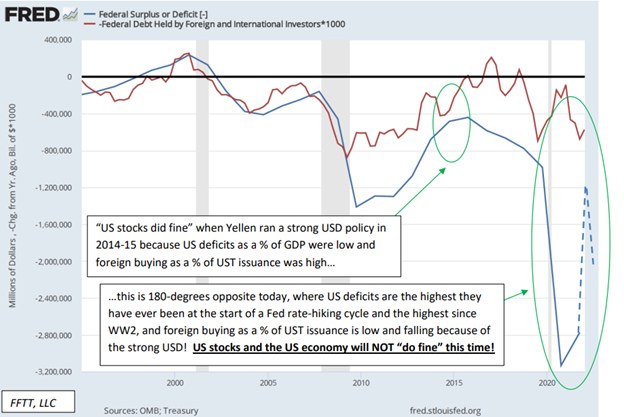
This “strong USD” plan has crippled just about every asset class but the USD, and only managed to lure a few foreign suckers into a tanking US market.
So, Mr. Powell, you’re in a debt corner of your own (and Janet’s, Ben’s and Alan’s) making, and I’ll say what you won’t, namely: You want more not less inflation to get Uncle Sam out of debt in the same way every broke regime from Rome to Paris to Tokyo to Ankara to DC has done and will do again–by inflating away their debt, crushing the (angry) man on the street and blaming the inflation (i.e., currency debasement) on anyone but themselves?
Mr. Powell, why not just say it out loud? Truth may be a rare political tool, but it is an equally stubborn thing.
Waiting for Gold
Meanwhile, and it the midst of so much political, cultural, financial, military and social chaos in 2022, gold’s performance has been less than favorable.
Retail investors are getting out of gold ETF’s ($1.7B last month) at the wrong time, which sadly, is what retail investors often do.
Ironically, and not surprisingly, the biggest buyers of gold of late are the central banks themselves, who having colluded to paper squeeze the gold price down before buying, are reaping the rewards of their manipulation games.
Foreign central banks are seeking gold as an alternative to a USD whose days of hegemony are coming to end.
As argued, US attempts to lure foreign money into tanking US markets via a stronger dollar and rising rates are both unsustainable and backfiring, but these forces have certainly put a temporary dent in the gold price trading in the 1700 range.
Of course, when measured against other currencies outside the USD, gold has done far, far better.
It’s fair, of course, to also remind that gold has suffered far less than bonds (S&P bond index down 9%), cryptos (down 75%) and stocks (S&P down 20%), but patient gold investors already know that.
Higher rates are a gold headwind, but not forever. Gold soared between 1971 and 74, and again between 1977 and 1980, as rates in the US were rising not falling.
Remember: Gold is a monetary metal, a store of value. It’s not a tech or growth stock. It’s loyal, and as such, it consistently surpasses its prior peaks, especially in the backdrop of rising inflation.
Stated simply, its bull market has yet to begin.
